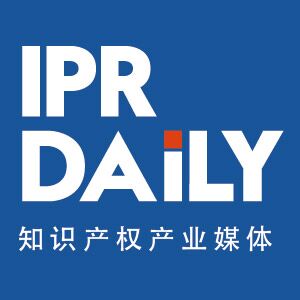没收到验证邮件?请确认邮箱是否正确或 重新发送邮件
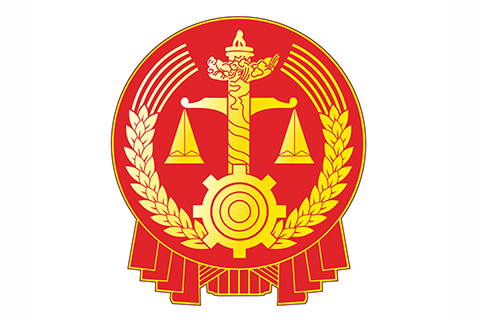
#文章仅代表作者观点,不代表IPRdaily立场#
原标题:最高人民法院知识产权法庭年度报告(2019)
IPRdaily消息:近日,最高人民法院知识产权法庭发布年度报告(2019)。报告指出,统一专利等技术类知识产权案件裁判标准,是法庭设立的重要目标。2019年,法庭立足司法审判职能,依法公正高效审结了一批专业技术性较强的知识产权案件,形成了一批具有典型示范作用的标杆性判决,建设实施“统一裁判标准系统工程”,进一步推动了技术类知识产权案件裁判尺度的统一。
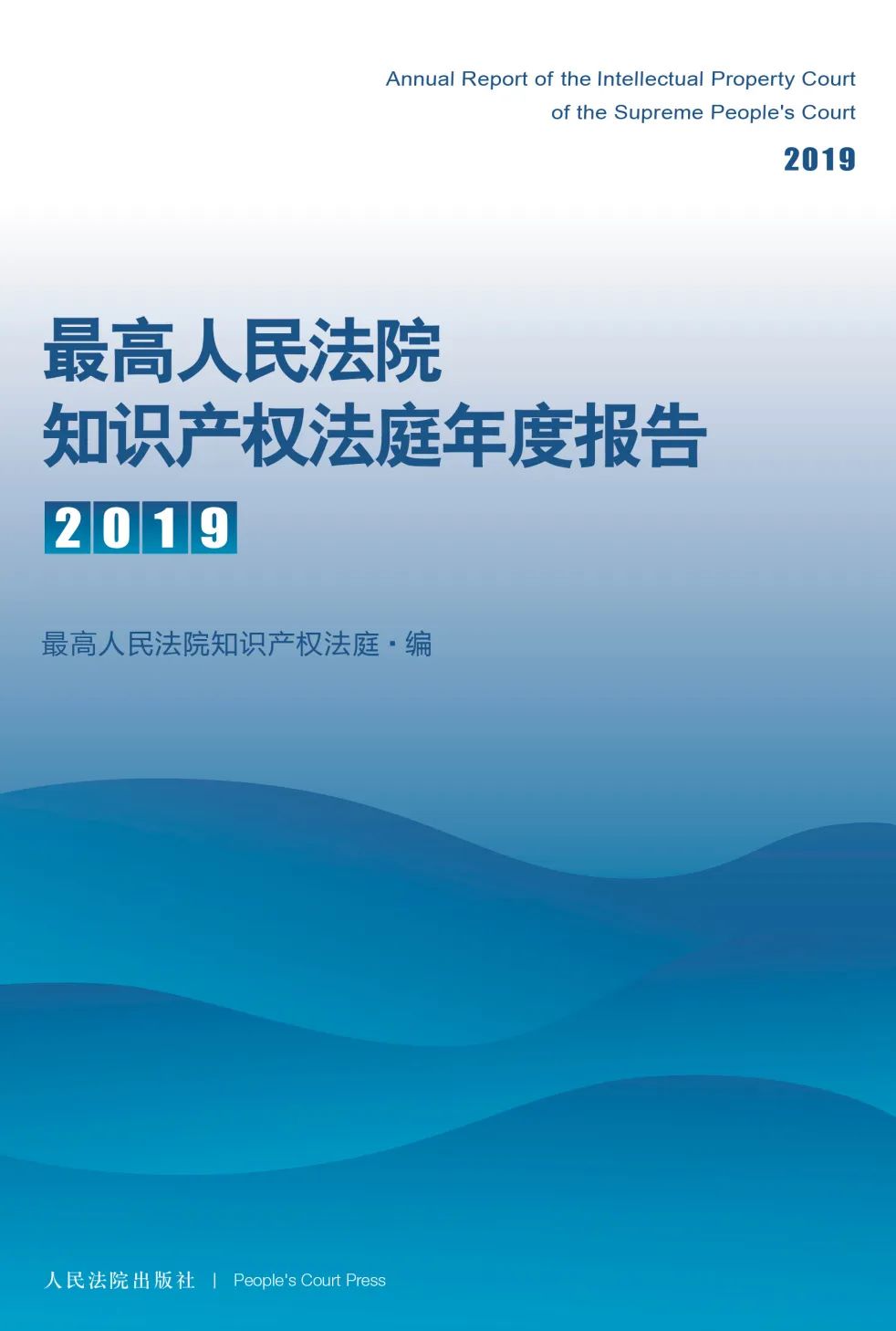
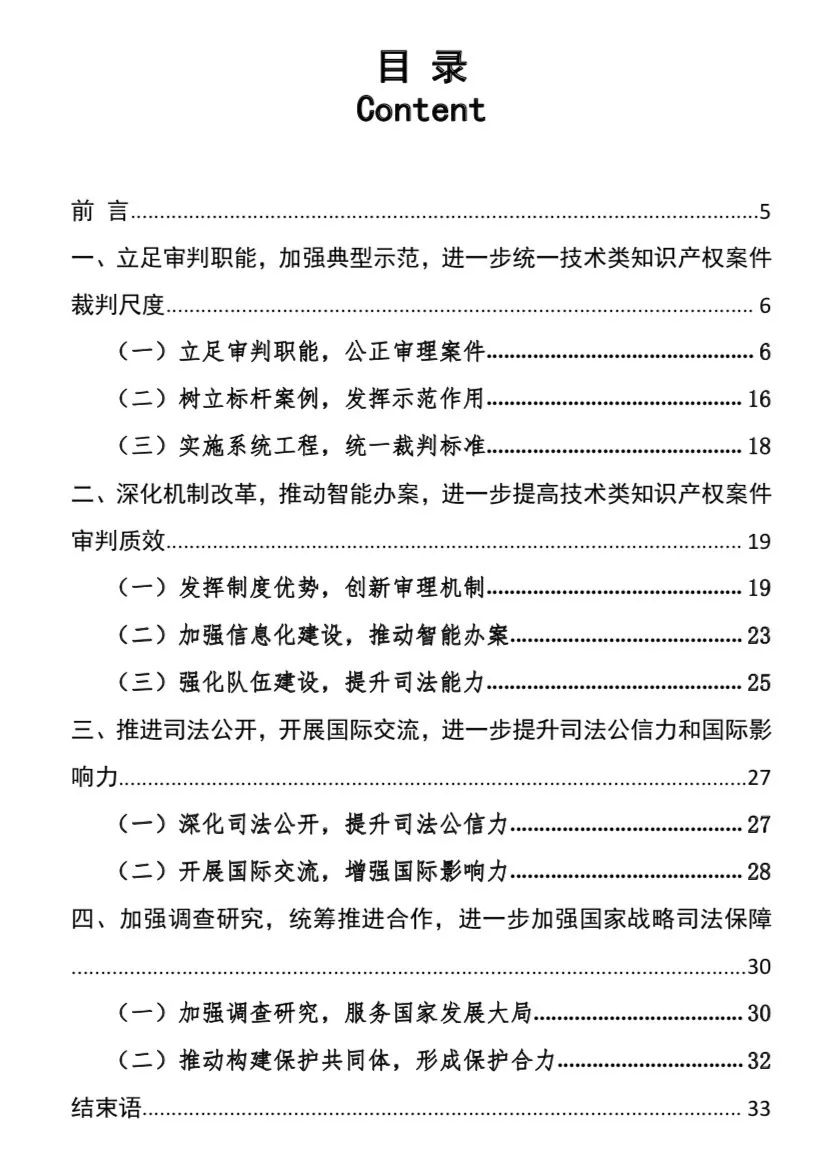
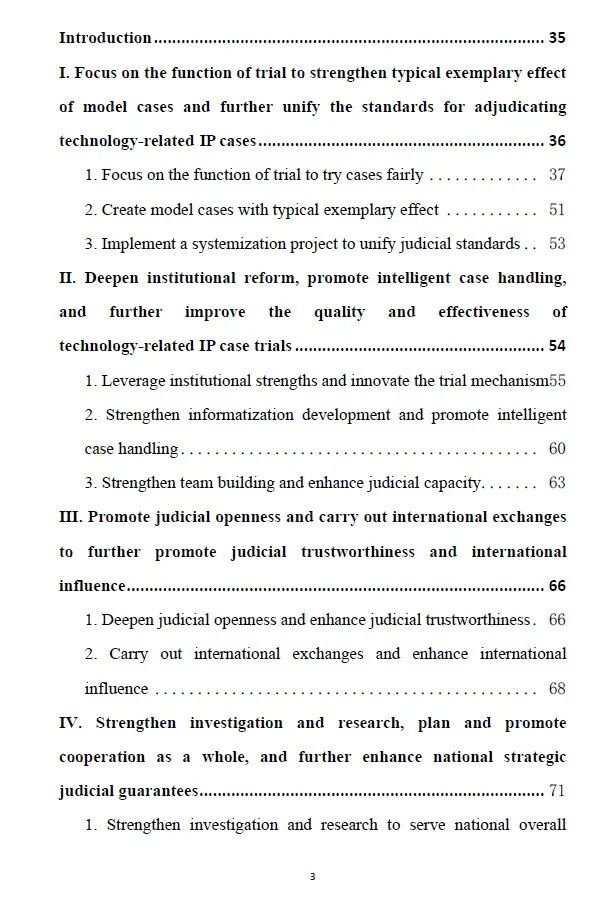
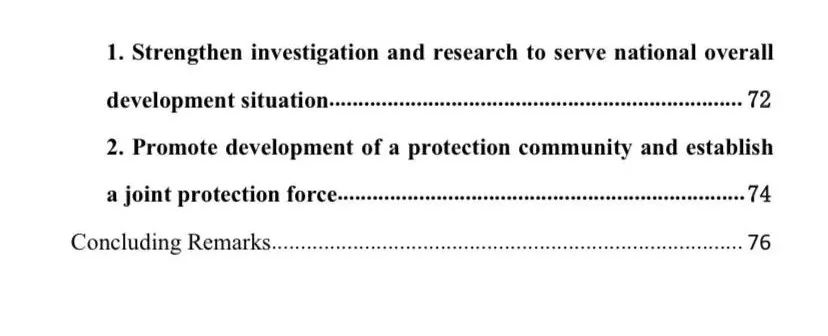
最高人民法院
知识产权法庭年度报告
(2019)
前 言
十八大以来,以习近平同志为核心的党中央大力实施创新驱动发展战略,高度重视知识产权保护,从建设知识产权强国和世界科技强国的战略高度,作出设立最高人民法院知识产权法庭(简称“法庭”)的重大战略决策部署。2019年1月1日,法庭正式揭牌成立,成为世界范围内首个在最高法院层面设立的专门化知识产权审判机构,行使统一审理全国范围内专利、垄断等技术类知识产权上诉案件的终审职能,承担进一步统一技术类知识产权案件裁判尺度、进一步提高审判质量和效率、进一步提升司法公信力和国际影响力、进一步为加强创新驱动发展战略和国家知识产权战略实施提供司法保障的职责使命。
自成立以来,法庭始终坚持以习近平新时代中国特色社会主义思想为指导,全面贯彻落实党的十九大和十九届二中、三中、四中全会精神,切实增强“四个意识”、坚定“四个自信”、做到“两个维护”。围绕党中央赋予的职责使命,积极在最高司法层面统筹国内国际两个大局,坚持“高起点、高标准、高水平、国际化”标准,秉持“创新、精进、智慧、卓越”庭训,不断深化技术类知识产权审判领域改革,充分发挥技术类知识产权审判激励和保护创新、促进科技进步和社会发展的职能作用,保障和服务国家经济社会发展大局,并在知识产权国际司法保护实践和规则形成中贡献中国经验和中国智慧,努力推动知识产权国际规则和治理体系朝着开放包容、平衡有效的方向发展。
一、立足审判职能,加强典型示范,进一步统一技术类知识产权案件裁判尺度
统一专利等技术类知识产权案件裁判标准,是法庭设立的重要目标。2019年,法庭立足司法审判职能,依法公正高效审结了一批专业技术性较强的知识产权案件,形成了一批具有典型示范作用的标杆性判决,建设实施“统一裁判标准系统工程”,进一步推动了技术类知识产权案件裁判尺度的统一。
(一)立足审判职能,公正审理案件
2019年,法庭共受理技术类知识产权案件1945件,审结1433件,结案率73.7%。其中,受理民事二审实体案件962件,审结586件;受理行政二审案件241件,审结142件;受理管辖权异议二审案件481件,审结446件;受理其它类型案件261件,审结259件。
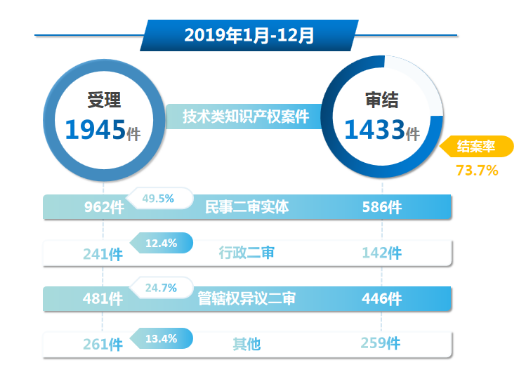
1.案件数据统计分析
(1)案件来源统计分析
2019年,法庭共受理各类二审案件1684件。其中,一审法院为中级人民法院的为1678件,占比99.6%,一审法院为高级人民法院的为6件,占比0.4%。
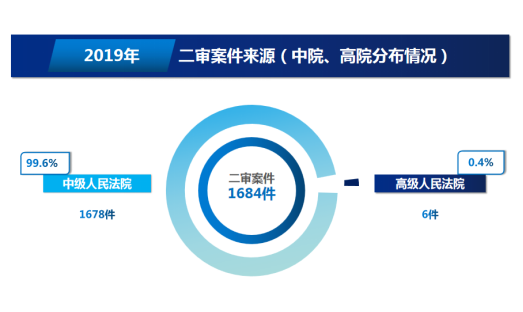
就案源地区分析,案件排名前十位的分别为北京知识产权法院(376件)、广州知识产权法院(297件)、上海知识产权法院(143件)、南京知识产权法庭(107件)、深圳知识产权法庭(96件)、宁波知识产权法庭(85件)、苏州知识产权法庭(71件)、杭州知识产权法庭(70件)、青岛知识产权法庭(67件)、济南知识产权法庭(53件)。上述数据大致反映出技术类知识产权纠纷在全国的分布情况,并表明:越是经济发达地区,涉技术类知识产权的经济活动越活跃,相关纠纷也越多。
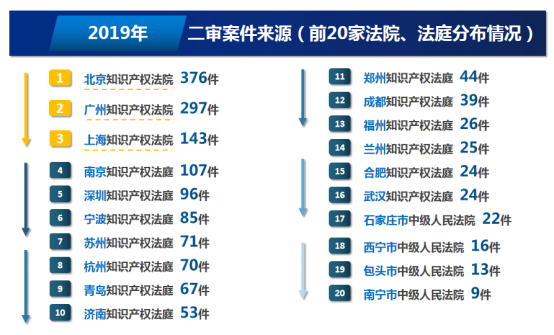
(2)案件类型统计分析
在法庭受理的962件民事二审实体案件中,侵害实用新型专利权纠纷454件,侵害发明专利权纠纷234件,涉计算机软件纠纷142件,涉专利代理、许可合同纠纷40件,技术合同纠纷26件,涉植物新品种权纠纷20件,涉技术秘密纠纷12件,涉垄断纠纷9件,专利申请权及专利权权属纠纷9件,涉确认不侵权纠纷8件,涉职务发明人报酬纠纷7件,涉集成电路布图设计纠纷1件。其中,占比较高的纠纷类型分别为侵害实用新型专利权纠纷(47.2%)、侵害发明专利权纠纷(24.3%)、涉计算机软件纠纷(14.8%)。
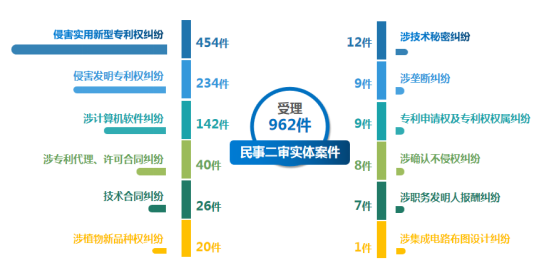
在法庭受理的241件行政二审案件中,行政授权确权类案件230件,行政处罚类案件7件,其他行政案件4件。在行政授权确权类案件中,发明专利权无效行政纠纷80件,发明专利申请驳回复审行政纠纷71件,实用新型专利权无效行政纠纷57件,实用新型专利申请驳回复审行政纠纷9件,外观设计专利权无效行政纠纷13件。其中,占比较高的纠纷类型分别为发明专利权无效行政纠纷(33.2%)、发明专利申请驳回复审行政纠纷(29.5%)、实用新型专利权无效行政纠纷(23.7%)。
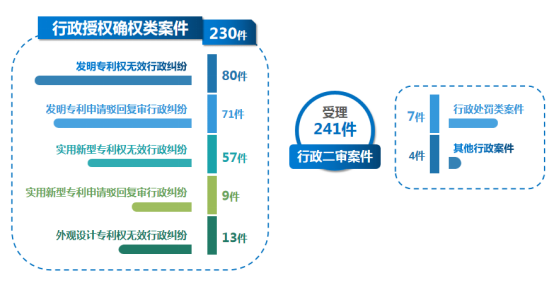
(3)裁判结果统计分析
2019年,法庭共审结二审案件1174件。其中,以维持原审裁判方式结案的为731件,以撤诉方式结案的为280件,以调解方式结案的为71件,调撤率为29.9%,以发改方式结案的为92件,发改率为7.8%。法庭发改的92件案件中,民事二审实体案件66件,管辖权异议二审案件21件,行政二审案件5件。

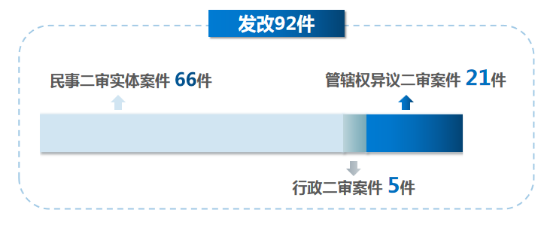
在法庭审结的586件民事二审实体案件中,以维持原审裁判方式结案的为236件,以撤诉方式结案的为213件,以调解方式结案的为71件,调撤率为48.5%,以发改方式结案的为66件,发改率为11.3%。
在法庭审结的142件行政二审案件中,以维持原审裁判方式结案的为126件,以撤诉方式结案的为11件,以改判方式结案的为5件,改判率为3.5%。
在法庭审结的446件管辖权异议二审案件中,以维持原审裁判方式结案的有369件,以撤诉方式结案的有56件,以撤改方式结案的有21件,撤改率为4.7%。
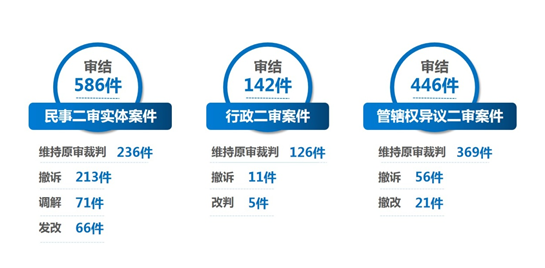
(4)审理周期统计分析
2019年,法庭二审实体案件平均审理周期为73天,管辖权异议二审案件平均审理周期为29.4天。法官人均结案39.2件。
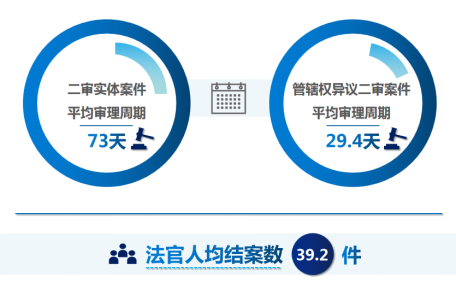
(5)涉外、涉港澳台案件统计分析
2019年,法庭共受理174件涉外、涉港澳台案件。其中,民事二审实体案件50件,行政二审案件52件,管辖权异议二审案件71件,其他案件1件。按地域统计,涉欧盟国家75件,涉美国54件,涉日本15件,涉韩国4件,涉加拿大、以色列各2件,涉澳大利亚、南非各1件,涉港澳台20件。
法庭共审结98件涉外、涉港澳台案件。其中,审结的实体案件为35件,外方当事人胜诉(包括部分胜诉)21件,港澳台方当事人胜诉3件,内地当事人胜诉11件。
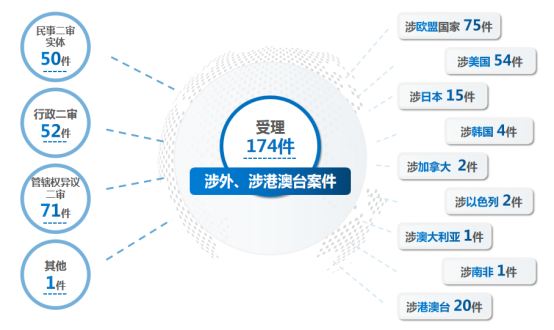
2.案件特点分析
(1)整体案件特点
2019年,法庭审理的技术类知识产权案件在整体上具有以下特点:涉及技术领域广,社会影响大,程序交织案件多,审理周期短,平等保护中外当事人的合法权益,加大司法保护力度的导向明显。
第一,涉及技术领域广。当事人诉请保护的知识产权类型涵盖了医药、基因、通信、机械、农林业等诸多与国计民生、前沿科技、衣食住行密切相关的领域。
第二,案件社会影响大。一是案件涉及的知识产权市场价值较高,权利人一审主张侵权赔偿额超过1000万人民币的案件有17件,过亿元的有3件;二是案件涉及标准必要专利、医药专利等前沿科技和国计民生,社会关注度高。
第三,程序交织案件多。法庭受理不少竞争性互诉案件,当事人在不同法院相互提起多个民事、行政诉讼,涉及不同审级、不同程序的关联案件多。法庭从审理程序、裁判尺度、统筹调解等多方面着手协调处理,成效较好,2019年审结的二审案件调撤率达29.9%。
第四,案件审理周期短。由于民事与行政程序交织、技术事实查明难度大等多方面因素,技术类知识产权案件的审理周期一般比较长。法庭2019年审结的二审实体案件平均审理周期仅为73天,技术类知识产权维权周期长的问题得到有效改善。
第五,平等保护中外当事人的合法权益。法庭受理的涉外、涉港澳台案件占比8.9%,有部分案件属于当事人之间跨国诉讼的一部分,与国外专利侵权诉讼相互影响。法庭坚持对中外各类市场主体的知识产权依法一视同仁、平等保护。
第六,加大司法保护力度的导向明显。运用诚信诉讼机制,在拒不履行文书提出命令、故意毁损被保全产品等情形下采取不利于该行为人的事实推定。在审结案件中,权利人胜诉案件占比61.2%。
(2)专利民事案件特点
法庭审理的专利民事案件具有以下特点:
第一,以权利要求解释与等同侵权判定为主要争议的案件较多。权利要求解释关系到专利权保护范围的确定与侵权比对的结果,法庭通过个案裁判在功能性特征的认定标准、主题名称对权利要求保护范围的限定作用、捐献原则的适用等方面进行了深入探索。多起案件涉及等同侵权判断问题,如何在维护权利要求公示作用的同时,给予专利权人以公平保护,成为案件审理的难点。
第二,合法来源抗辩、现有技术抗辩、先用权抗辩为最常见的抗辩事由。提出合法来源抗辩的案件占比最大,争点多集中在举证责任的分配、免除赔偿责任的范围等方面。现有技术抗辩的提出较为随意,当事人在二审程序中才首次提出该抗辩的案件占有一定比重。
第三,具有商业维权色彩的关联案件占有一定比例。此类案件表现为权利人以同一专利在全国各地进行批量商业维权,所涉专利多为未经实质审查的实用新型专利,被诉侵权人多为居于商品流通环节下游的小型销售商。
(3)专利行政案件特点
法庭审理的专利行政案件具有以下特点:
第一,涉发明专利、涉高新技术领域的案件多。三种专利类型中,最具技术含量的发明专利的案件数量,在无效宣告和驳回复审案件中均居于首位,体现了创新主体和相关公众对专利价值的重视。在技术领域方面,机械领域的案件总数最多,但在无效宣告案件中,电学领域与机械领域的案件数并列最多,其中不乏通信技术、计算机等高新技术领域的纠纷。化学领域的无效宣告案件虽总体数量不多,但普遍集中于医药、生物技术等重要产业领域。
第二,多数案件以创造性判断为主要争点。涉及创造性判断的案件共92件,在审结的专利行政案件中占比约70%;在撤改一审裁判的案件中,涉及创造性判断的占比80%。法庭在该类案件的审理中,注重通过“三步法”判断非显而易见性,规范商业成功因素等辅助判断的适用,对化合物药物新晶型、涉保藏生物材料等类型发明的创造性判断进行探索,确保真正有价值的发明创造依法获得保护。
第三,驳回复审案件中自然人作为申请人的案件较多。在审结的57件专利驳回复审案件中,自然人作为申请人的案件占比75%以上,绝大多数因不具备创造性、少数因不具备实用性或不符合授权主题而被驳回。因错误理解专利行政诉讼起诉期限的计算方式而导致起诉不予受理的10件案件中,申请人均为自然人。
(4)涉计算机软件案件特点
法庭审理的涉计算机软件案件具有以下特点:
第一,案件类型较为集中。计算机软件案件主要包括合同案件和侵权案件两类。其中,计算机软件合同案件占全部计算机软件案件总量的80%以上。
第二,争议焦点较为集中。尤其是计算机软件合同案件的争议焦点,主要集中在开发成果是否交付、交付内容是否符合约定、履行中的变更是否已经达成合意、迟延履行应当如何认定等问题。
第三,审理难度差异大。计算机软件侵权案件中,如果双方对于软件侵权的技术事实争议较大,则往往涉及复杂的源程序比对,审理难度很大;反之则审理难度较低。计算机软件合同案件中,如果合同约定模糊、有关履约标准难以确定,则审理难度较大;反之则审理难度较低。
(5)管辖案件特点
法庭审理的管辖案件具有以下特点:
第一,案件数量较多。基于诉讼策略、管辖规则复杂性、管辖连结点更多等因素,被诉侵权人在知识产权案件中对于管辖权异议有更大争辩空间。
第二,新难问题较多。如垄断协议纠纷的管辖是否适用协议中的仲裁条款,共谋达成垄断协议的行为实施地可否作为垄断纠纷的管辖连结点,未起诉销售商的情况下能否将网络平台商作为管辖连结点,确认不侵权案件中专利权人主张的侵权行为实施地可否作为管辖连结点,等等。这些问题反映出,伴随科学技术、商业模式以及维权实践的不断发展,技术类知识产权案件的管辖呈现出日趋复杂与多样化的特点。
第三,司法态度较宽容。法庭审结446件管辖权异议二审案件,以撤改方式结案的仅为21件,占比4.7%。出于保护权利人依法行使诉讼权利,以及适度促进司法竞争的考虑,法庭对权利人选择案件管辖连结点持较为宽容的司法态度,尊重权利人对纠纷管辖法院的选择权。
(6)其他类型案件特点
法庭审理的涉植物新品种权案件具有以下特点:第一,涉及的品种与人们日常生活息息相关,如玉米、水稻、蜜柚、花卉等;第二,技术事实的查明难度较大,尤其是“同一性”的判断难度较大;第三,案件涉及的法律问题多元化,如诉讼主体资格、品种权保护范围、合法来源抗辩、侵权赔偿数额等。
法庭审理的技术合同案件,多数以违约行为的审查认定为审理重点,技术事实的查明对违约行为的认定多具有重大影响。
法庭审理的涉技术秘密案件,涉及程序问题较多,程序规则得到进一步明确。
(二)树立标杆案例,发挥示范作用
法庭作出的裁判是最高人民法院的裁判,具有终局性和权威性。法庭充分利用技术类知识产权案件二审集中管辖的优势,打造出一批有社会影响力、有统一法律适用标准价值的标杆案例,发挥引领示范作用。
2019年3月27日,知识产权法庭由庭长罗东川、副庭长王闯等五人组成合议庭敲响法庭“第一槌”,公开开庭审理了上诉人厦门卢卡斯汽车配件有限公司、厦门富可汽车配件有限公司与被上诉人法国瓦莱奥清洗系统公司等侵害发明专利权纠纷一案。从立案、开庭到结案送达,案件审理过程用时仅50天。该案涉及专利侵权纠纷的先行判决问题,具有前沿性。通过该案,法庭明晰了功能性特征的认定标准,阐明了判令停止侵害的部分判决尚未发生效力时临时禁令的独特价值,明确了判令停止侵害的部分判决制度和临时禁令制度并存适用的条件和规则。该案被确定为最高人民法院指导性案例,并被评为2019年十大民事行政案例。
以“第一槌”为样板,法庭根据不同技术领域知识产权的特性,通过个案智慧总结类案经验,树立了一批标杆案件。如在机械领域,上诉人无锡海斯凯尔医学技术有限公司与被上诉人弹性测量体系弹性推动公司、原审被告中日友好医院侵害发明专利权纠纷案,所涉专利为“肝病无创诊断仪”,该案对专利侵权诉讼中权利要求保护范围的解释、举证责任的分配、相同和等同技术特征的判断等问题确立了裁判规则。在医药领域,上诉人国家知识产权局与被上诉人伊拉兹马斯大学鹿特丹医学中心、罗杰•金登•克雷格发明专利驳回复审行政纠纷案,涉及的发明为前沿生物基因技术药物,法庭厘清了专利创造性判断与说明书充分公开等法律标准的关系,促使专利审查实践中创造性判断标准回归核心和本质,并对如何在创造性判断中避免“后见之明”给出了明确指引。在通信领域,上诉人深圳市吉祥腾达科技有限公司与被上诉人深圳敦骏科技有限公司等侵害发明专利权纠纷案,所涉专利为“一种简易访问网络运营商门户网站的方法”,该案以网络通信领域的技术特点为重要考量因素,确定了多主体实施方法专利的侵权判断规则:以生产经营为目的,未经许可将专利方法的实质内容固化在被诉侵权产品中,对专利权利要求的技术特征被全面覆盖起到了不可替代的实质性作用,即构成侵害方法专利权。在植物新品种领域,上诉人蔡新光与被上诉人广州市润平商业有限公司侵害植物新品种权纠纷案,所涉植物新品种为“三红蜜柚”,该案对植物新品种权保护范围以及被诉侵权行为的认定等问题确立了裁判规则,指出在植物体既是繁殖材料又是收获材料的情形下,应审查被诉侵权的销售者将其作为繁殖材料还是收获材料进行销售的真实意图。
(三)实施系统工程,统一裁判标准
一年来,法庭建设和实施“统一裁判标准系统工程”,形成专项规范、分段保障、严管重点的工作体系,为统一技术类知识产权案件的裁判标准提供了制度和体系保障。
在制度建设方面,制定了《知识产权法庭统一裁判标准实施细则》,明确将涉及同一专利的案件原则上分配给同一法官或者合议庭,保障裁判标准统一。在前端梳理方面,采取系统比对、人工复核等多项措施识别类案,将涉及相同专利的民事案件、民行交叉案件与当事人关联案件等类案集中分配给同一合议庭。在中间把控方面,完善法官会议制度,法庭全年召开了34次法官会议,统一了120个裁判规则,并印发《法官会议纪要摘编》和《办案提示》,使法官及时掌握重要裁判标准和类案办理方式;利用“知识产权法庭讲坛”“新知大讲堂”等平台,推动法庭内部形成裁判共识;举办“知识产权法庭工作部署暨业务培训班”“全国法院技术类案件审判实务培训班”,加强对下指导和裁判规则的向下传导。在末端审核方面,发挥法官会议对标杆案件、重大敏感案件的裁判文书的把关作用,实施文书评查制度,提升裁判文书质量。在重点案件方面,建立大要案专报和指导机制,编发28期《知产法庭工作信息》及特刊,为领导决策提供参考。
二、深化机制改革,推动智能办案,进一步提高技术类知识产权案件审判质效
作为世界范围内首个在最高法院层面设立的审理全国范围专利等技术类知识产权上诉案件的专门化司法机构,法庭锐意进取,勇当改革先行者和探索者,创新体制机制,推进信息化建设,强化队伍能力,全方位多措施提升技术类知识产权案件审判质效。
(一)发挥制度优势,创新审理机制
以创新的方式保护创新,以改革的思维推进改革。一年来,法庭在技术类知识产权案件诉讼制度方面实现了一系列突破和创新。
实行集中统一管辖制度和中国特色“飞跃上诉”制度。根据全国人大常委会《关于专利等知识产权案件诉讼程序若干问题的决定》,法庭集中统一管辖全国范围技术类知识产权民事和行政上诉案件。无论技术类知识产权案件一审裁判由中级人民法院还是高级人民法院作出,对其提起的上诉均由法庭受理。最高人民法院在中级人民法院一审的技术类知识产权案件的上诉管辖上,跨越了高级人民法院,形成了具有中国特色的“飞跃上诉”制度。这不仅有助于统一裁判标准和缩短纠纷解决周期,也凸显了中国最高司法层面对技术类知识产权案件的司法政策和裁判规则。
探索涉及同一专利民事与行政案件的协同审理机制。我国专利制度采用民事侵权程序与行政无效程序的二元分立体制,该体制在实践中产生的问题是:一方面,专利民事侵权程序往往受到行政无效程序的影响和制约,程序交叠造成维权周期延长和维权结果反复;另一方面,专利权人可能利用分立程序做出不同的权利要求解释,在无效程序中以限缩的保护范围争取获得确权,而在民事侵权诉讼中以扩大的保护范围获得侵权认定中的优势,从而“两头获利”。法庭充分利用审理权限集中的优势,在北京知识产权法院与其他地方法院的支持配合下,建立涉及同一专利民事与行政案件审理工作协同推进机制,实现权利效力判断与侵权判断两大诉讼程序和裁判标准的对接,从机制层面解决专利诉讼周期长、权利人就同一专利在不同案件中对权利要求解释不一致的问题。具体做法是,法庭汇总涉及相同专利的民事、行政案件信息,转递至专门受理专利行政诉讼的北京知识产权法院,协调案件审理进程、统一案件裁判标准。对于已进入二审阶段的此类案件,法庭在“前端梳理”识别的基础上,积极探索在现行法律框架下破解“二元分立”问题的审理机制。如乐金电子(天津)电器有限公司与厦门实正电子科技有限公司专利权无效行政纠纷、侵权纠纷两案,涉及同一专利,法庭组成相同合议庭,指派相同技术调查官,合并召开庭前会议,聚焦审理共同涉及的权利要求解释问题,并记载在裁判文书中,架起了专利行政确权诉讼与民事侵权诉讼之间的沟通桥梁,是实现专利侵权民事诉讼与确权行政诉讼裁判标准对接的一次有益探索。
建构“1+76”技术类知识产权审判格局,建立统筹联动机制。全国有32个高级人民法院、44个中级人民法院对技术类知识产权案件享有一审管辖权,以法庭为上诉机构的“1+76”审判格局已初步构建,形成“全国一盘棋、上下一条线”,逐步发挥出统筹联动机制的优势和整体效能。一年来,法庭以统筹联动机制为依托,扩展纠纷化解渠道方式,跨区域调解80个专利侵权案件,实现了“庭未开、案已结,人未走、事已了”的良好效果。如在上诉人佟勇华、宁波照华公司与被上诉人余姚普德水器材厂等侵害发明专利权纠纷一案中,法庭了解到该案当事人就涉案专利与相关专利在不同地区、不同法院尚有其他未结案件,遂联系杭州知识产权法庭、宁波知识产权法庭,协调合作、共同参与调解工作,推动涉及三地两级法院的8个案件一揽子化解。在上诉人江苏宝雕公司与被上诉人重庆银钢公司等侵害发明专利权纠纷一案中,法庭在江苏、四川、重庆等地高级法院的支持下,跨地域、跨程序一揽子化解7件一审、二审与再审案件。
实行全国范围巡回审判制度。坚持以人民为中心,依托最高人民法院六个巡回法庭和地方法院,探索“知产法庭+巡回法庭”巡回审判模式,建立“勘验+庭审”案件审理机制,到纠纷发生地或者一审人民法院所在地巡回审理案件,方便当事人诉讼,促进纠纷就地就近从快解决。一年来,法庭赴南京、深圳、济南、郑州、格尔木等地,对潜水泵、大型丝印机等不便运输的大型机械设备进行现场勘验,共完成23个案件的现场勘验和巡回审判,方便了群众诉讼,丰富了“枫桥经验”的知识产权保护实践。如在上诉人东莞市腾飞网印设备有限公司与被上诉人广东皓达科技有限公司、原审被告珠海红森电路板有限公司侵害实用新型专利权纠纷一案中,因被诉侵权的大型丝印机不便运输,且被诉侵权人上诉主张一审法院未就涉案专利权利要求1包含的50余项技术特征进行一一比对,故合议庭决定到位于珠海的工厂现场进行侵权比对,并在位于深圳的最高人民法院第一巡回法庭公开开庭审理了本案,最终在查明技术事实的基础上支持了上诉人的上诉请求。
完善技术事实查明机制。首先,牵头筹建“全国法院技术调查官、技术咨询专家库”,汇集全国各地技术调查官、技术咨询专家360余人,覆盖30多个技术领域。其中既有人民法院聘任的技术调查官,也有来自国家知识产权局、科技企业、高校、科研院所的交流、兼职、志愿者等形式的技术调查官与技术咨询专家,有效解决技术事实查明人才来源单一、领域不均、供应不足的问题。其次,建立“全国法院技术调查资源共享机制”,适用《最高人民法院关于技术调查官参与知识产权案件诉讼活动的若干规定》,推动在全国范围内按需调派技术调查官,或参照该规定调派技术咨询专家。共享机制与专家库协同发力,使技术调查人才通过统一调派在全国范围内按需流动,发挥既有资源的最大效用。2019年7月,应宁夏回族自治区银川市中级人民法院申请,法庭调派一名机械领域的技术调查官参与“免耕式双垄沟全铺膜覆土联合作业机”发明专利侵权纠纷一案的审理工作。2019年11月,法庭应天津知识产权法庭申请,综合考虑地域、领域、人员等情况,通过“全国法院技术调查官、技术咨询专家库”从北京知识产权法院调派一名生物医药领域的技术调查官参与“作为心血管的标志和治疗靶的1L1RL-1”发明专利侵权纠纷一案的审理工作。2019年12月,南京知识产权法庭积极调派计算机软件领域技术调查官,协助最高人民法院知识产权法庭计算机软件侵权案件审理,本案复杂的源程序事实问题得以正确查明,当事人在新事实的基础上自愿达成和解,案件得以圆满解决。最后,针对实践中存在的技术调查官工作认知习惯差异大、参与诉讼细节规范不统一等问题,法庭牵头组织北京、上海、广州三家知识产权法院,以及天津、深圳、南京、苏州等地知识产权法庭共同编写,发布《技术调查官工作手册(2019)》,为全国法院技术调查官查明技术事实提供工作指引和范式。
(二)加强信息化建设,推动智能办案
信息化技术是提升司法审判质效的重要手段,法庭高度重视信息化建设工作,探索大数据、人工智能等新一代信息技术在审判工作中的应用,在裁判规则数据库、科技法庭、远程质证等方面取得了积极进展,并对信息化建设工作的未来发展进行了统筹规划。
第一,建立以法律适用具体规则为中心的新型裁判规则数据库。首批上线的裁判规则来自最高人民法院指导案例、最高人民法院知识产权年度报告、全国法院典型案例,以及法庭2019年审结的具有指导意义的案例,由法庭法官提炼、撰写,再进行系统梳理和分类。使用者在该数据库输入关键词,即可获得以“规则脑图”和“规则列表”两种形式展现的相关裁判规则。这一展现形式,是根据案件的类型、领域等特点,按照法律逻辑予以构建,呈现系统性的知识结构,区别于通常的简单罗列形式,可引导使用者主动学习并掌握相关规则。该数据库既可运用于辅助类案审理,也可运用于检验审判质效。目前,裁判规则数据库试运行版已经完成,即将正式上线运行,为全国法院技术类知识产权案件智能审判提供有力支持。
第二,建设集信息化终端运用、同步圈画技术、AR技术、语音识别技术与电子签名技术等多项技术于一体的科技法庭。开庭时,法官席的信息化终端与办案系统连通,法官可调阅电子卷宗资料。终端内嵌同步圈画技术,质证过程中,法官和当事人均可通过各自终端用不同颜色的线条、色块在证据上进行标记,实现同步圈画。科技法庭还可运用AR技术,通过AR眼镜的现实增强技术将电路布图等比较微小、结构精密的证据投到大屏上,便于查看细微结构。科技法庭的语音识别技术与电子签名技术,可以将语音转换为文字实时生成庭审记录,并以电子签名代替传统签字,通过一次电子签名即可实现在庭审笔录的每一页均完成签名。
第三,利用高清视频远程传输技术进行远程质证。对于不便移送的证据,法庭通过高清视频远程传输技术进行远程质证。在上诉人北京热刺激光技术有限公司、上海容东激光科技有限公司与被上诉人上海嘉定马陆东方激光管厂侵害发明专利权纠纷一案中,被诉侵权产品系玻璃易碎品,不便远途运输,法庭与一审法院上海知识产权法院沟通协作,实现了证据的远程实时展示与质证比对。
第四,统筹规划信息化建设工作的未来发展。法庭制定了《知识产权法庭智能化建设三年发展规划(2019-2021)》,明确信息化建设目标和思路,提出了“一个平台”“两个服务”“三个场景”“四个连接”“五个重点项目”的建设思路,打造全面覆盖、互联互通、跨界融合、深度应用、透明便民、安全可控的法庭智能化办案系统。“一个平台”是指法庭电子诉讼平台,面向法官、诉讼参与人、社会公众提供全方位智能服务。“两个服务”是指坚持服务人民群众、坚持服务审判工作。“三个场景”是指将信息化建设成果体现在诉讼服务、科技法庭、大数据分析平台三个场景中。“四个连接”是指连接有关下级法院、外部单位、当事人、社会公众。“五个重点项目”是指裁判规则数据库、大数据分析平台、外部数据交互平台、两级协同平台与远程庭审系统、知产法庭云。
(三)强化队伍建设,提升司法能力
队伍建设是审判事业行稳致远的基础和保障。技术类知识产权审判兼具专业性、前沿性和国际性等特点,审判人员既要有坚定的政治立场,又要有高超的业务能力,还需有慎独慎微的廉洁品质,方能有效提升司法能力,成为审判质效提升的人才保障。
法庭下设8个合议庭以及诉讼服务中心与综合办公室,共140名工作人员。法官42人,全部具有硕士研究生以上学历,其中37.5%为博士研究生学历,22.5%有理工科背景,17.5%有海外留学经历。部分法官是从最高人民法院选派,多数法官是从全国专利审判较为成熟的地方法院借调,还有3名法官是在国家知识产权局的支持下来法庭交流。法庭的审判队伍,经过层层筛选,实现了优中选优,是一次全国范围内的“沙场点兵”。法庭充分发挥人才优势,高标准、严要求、多渠道进一步加强队伍建设,努力锻造一支政治坚定、清正廉洁、精通法律、熟悉技术、既理解中国国情又具有国际视野的审判队伍。
第一,加强政治建设,提升队伍凝聚力。法庭坚持以习近平新时代中国特色社会主义思想为指导,增强“四个意识”、坚定“四个自信”、做到“两个维护”,坚持党对人民法院工作的绝对领导,确保党中央决策部署在法庭得到不折不扣的贯彻落实,确保知识产权审判工作正确政治方向。落实新时代党的建设总要求,全面提升队伍素质能力,树立正确选人用人导向,弘扬正气,创先争优,充分调动各位干警的积极性、主动性和创造性,激励法庭干警在新时代新环境有新担当新作为。
第二,加强业务建设,提升队伍履职能力。根据知识产权领域思维活跃、知识更新快、国际化程度高等特点,法庭积极创造条件,针对性地加强知识产权业务培训与外语能力培训,提升队伍履职能力。一年中,举办两期全国审判实务培训班,深入讲解司法政策和裁判规则,促进全国条线工作统一思想、步调一致;开展多层次业务培训,搭建“新知大讲堂”“法庭讲坛”等高质量常态化学习平台,邀请全国知名专家学者到法庭授课,并向地方法院同步直播,提升审判队伍的业务素质;组建法庭外语工作组,开展线上线下日常外语培训,翻译域外裁判及前沿学术文章。法庭充分发挥全国审判业务专家的榜样作用,发挥以点带面的“领头羊”作用,努力成为全国法院技术类专业审判队伍的熔炉和学校。
第三,加强廉洁建设,锻造作风过硬队伍。一方面,根据审判工作实际,借助新媒体,探索形成“线上线下全覆盖、教育管理全天候”党建工作法,以“党员之家”“学思践悟”“知否,知否?”等不同主题的线上互动微平台,以及“党建园地”宣传廊等线下学习教育平台为媒介,以立体化、年轻态、互动性为导向,搭建党建学习平台,紧贴工作实际设置学习内容,采取互动问答、互教共享的方法检视学习效果,打造喜闻乐见的党建品牌,在中央和国家机关工委《旗帜》杂志举办的第二届党建创新成果评选活动中被评为“百优案例”。另一方面,建立以《知识产权法庭关于从严治庭防范风险的意见》为统领的“1+N”制度体系,形成规章制度50余项,采取发送“知产家书”等创新形式,增强制度的执行力和约束力,推动形成良好的廉政生态。
三、推进司法公开,开展国际交流,进一步提升司法公信力和国际影响力
在全面建设法治社会,推进司法体系和司法能力现代化的背景下,社会对司法公开的广度与深度有着极高的要求。法庭在社会关注、国际瞩目中诞生,秉持高度的自觉性、崇高的使命感,主动推进司法公开,积极参与国际交流,使国内外能够全面、客观地了解法庭技术类知识产权司法保护的制度与实践。
(一)深化司法公开,提升司法公信力
围绕“努力让人民群众在每一个司法案件中感受到公平正义”目标,法庭以司法公开为核心,以司法宣传为抓手,不断增强司法工作的透明度,促进司法公信力的提升。
以司法公开为核心,依法充分公开审判信息。法庭依托最高人民法院搭建的中国审判流程信息公开网、中国庭审公开网、中国裁判文书网、中国执行信息公开网等四大公开平台,实现审判流程的全方位公开。在庭审公开方面,法庭以公开、直播为原则,以不公开为例外。案件的庭审过程既可以在互联网上实时观看,也可以庭后登录中国庭审公开网查看录像。重大案件全流程公开,以公开促公正。在裁判文书公开方面,对于依法应予公开的裁判文书,法庭及时通过中国裁判文书网发布。为提升公众对裁判的认知度,法庭制作的裁判文书均附有裁判要点,对案件所涉法律问题、裁判观点、裁判结果均予以简要释明,以清晰、理性的释法阐理让正义讲得明、看得见。
以司法宣传为抓手,全方位展示法庭工作情况。2019年3月27日,法庭的“第一槌”案件开庭审理,经中央电视台等数十家媒体进行全媒体直播和广泛报道,庭审网络直播第一时间观看量达1800余万次。4月下旬,法庭举办“公众开放周”“知识产权保护集中开庭周”“法官进校园”等一系列活动,邀请来自社会各界的公众和媒体记者参观法庭,体验诉讼材料电子递交、典型案例线上检索等智能化系统,旁听公开庭审;安排法官走进清华大学、中国人民大学、北方工业大学等高校,宣介法庭的基本情况与我国知识产权司法保护的发展。12月9日至13日,法庭开展“集中宣判周”活动,对6件具有标杆意义的案件进行集中宣判,旁听的业界人士表示:“旁听庭审让我感受到了知识产权法庭审判的专业性和客观性。”法庭还充分利用中英文官网及微信公众号及时发布各类司法信息,共计发稿390篇,点击量1601.2万次。
(二)开展国际交流,增强国际影响力
法庭通过对外交流,学习借鉴国际上保护知识产权的成功做法,同时向世界讲述中国知识产权法治故事,为世界法治文明贡献中国智慧。一年中,法庭共开展外事交流活动32次,其中接待来访18次,出访8次,参加国内涉外活动6次。
第一,加强交流互鉴,“迎进来”充分展示严格保护知识产权国家形象。自成立以来,法庭坚持深化知识产权国际交流合作,先后接待了世界知识产权组织、国际知识产权保护协会、美国知识产权法律协会、美中贸易全国委员会、国际法院等组织到庭参观座谈。世界知识产权组织总干事弗朗西斯•高锐在法庭揭牌成立时发来视频表示祝贺,认为法庭的成立“体现了中国对知识产权保护的庄严承诺,表达了中国为知识产权提供更加公正高效司法保护的坚定决心”。美中贸易全国委员会会长克雷格•艾伦来法庭参访时表示,法庭的设立“对于打造国际化、市场化、法治化的营商环境具有重要意义”。美国知识产权法律协会执行董事丽莎•约根森参访时表示,“知识产权法庭有素质非常高的法官,案件的审理会很有效很全面,会对以后的判决一致性有很大的影响。”国际法院院长阿布杜勒卡维•艾哈迈德•优素福到访时表示,“国际上的知识产权专家、律师们都会非常关注知识产权法庭所做的判决。……法庭必定会对于知识产权中具有争议的热点问题有自己的判断,比如药品可及性与强制许可、垄断案件中相关市场界定、专利权人和专利使用者、社会公共利益之间关系的平衡等。我相信发展中国家会尤其关注中国在上述类似问题中的作用和采取的路线。”古巴最高人民法院院长鲁本•雷米希奥•费罗到访时表示,“最高法院的各个法庭就各种类别的案件进行专门的数据处理,进行案例的汇总以及检索,这非常具有学习借鉴意义。最令人称道的是随着信息技术的使用,让这些高科技的技术进入到法庭来帮助法官对高技术类的案件做出更为正确的审判,这是非常好的应用。”
第二,坚持国际视野,“走出去”用心讲述中国知识产权法治故事。法庭通过积极参与国际交流活动,展示中国技术类知识产权司法保护的成果,宣传中国技术类知识产权司法保护的理念,争取国际社会对于中国知识产权保护情况的认知、理解和认同,为知识产权国际规则的制定贡献中国智慧和中国方案。2019年5月,法庭副庭长王闯率中国专利法官代表团一行8人,赴法国、卢森堡和德国进行技术类知识产权案件审判专题交流,向欧洲知识产权司法和实务界介绍法庭的设立与我国技术类知识产权司法审判制度的创新发展,传递了我国大力加强知识产权司法保护的强烈信号。2019年6月,法庭副庭长周翔参加由国际知识产权保护协会中、日、韩三国分会联合主办的“2019AIPPI中日韩三国分会交流会”,并做英文主旨演讲,全面介绍法庭的机构设置和创新工作机制,以及中国知识产权司法保护的最新发展。一年中,法庭还有多位法官“走出去”讲述中国知识产权法治故事,如赴美国哈佛大学、耶鲁大学进行英文宣讲,赴英国参加2019年度AIPPI世界大会“模拟法庭”活动,赴瑞士参加世界知识产权组织执法咨询委员会会议,赴西班牙参加欧盟知识产权局举办的“知识产权调解大会”,赴新加坡参加知识产权周活动全球论坛,赴南非参加“国际无性繁殖观赏植物与果树育种者协会”年会,赴韩国参加WIPO“知识产权争端解决继续教育课程”,等等。
四、加强调查研究,统筹推进合作,进一步加强国家战略司法保障
技术类知识产权司法保护,事关创新驱动发展战略实施与经济社会文化高质量发展,对提升国家战略实力具有重要意义。法庭充分利用案件数量多、涉及技术领域广的调研优势,结合司法审判深入开展调查研究,服务决策并提出立法建议,同时积极推动知识产权保护共同体的构建,形成保护合力,促进中央决策和国家战略精神落地生根。
(一)加强调查研究,服务国家发展大局
第一,起草编制了《知识产权法庭发展规划(2019-2021)》,对法庭建设的指导思想、发展原则、发展目标、主要任务、基础保障、组织实施等方面进行了统筹谋划,推动法庭长远发展,确保中央部署落到实处。
第二,推进各项专题调查研究。来自全国各地区、各技术领域的大量案件为调研工作提供了优质资源,法庭以审判团队为基础,根据审判工作需要与法官的研究兴趣,围绕专利法修改、反垄断、技术秘密、集成电路布图设计、5G技术、植物新品种等战略领域与重点问题成立调研小组,开展专题调研。已形成《关于药品专利链接制度的立法建议》《关于植物新品种权案件裁判文书分析情况的报告》《专利侵权案件审理周期及专利无效循环诉讼实证研究》等9项调研成果,并就专利法第四次修改向全国人大常委会法工委提交《关于改革和完善专利无效程序立法的建议》。法庭还与广州知识产权法院交流合作,就标准必要专利等问题开展调研,研究与行业发展相适应的审判规则。
第三,植物新品种调研取得可喜成果。法庭被农业农村部评为2019年全国农业植物新品种保护先进集体。为提高中国种业的自主创新能力,为种业发展及国家粮食安全提供司法保障,法庭在审理好植物新品种纠纷案件的基础上,开展了一系列调研工作。梳理全国法院近十年审理的植物新品种纠纷案件,形成人民法院植物新品种裁判十年综述;与农业农村部开展植物新品种保护联合调研,赴湖南、海南两省实地考察,为湖南种业硅谷、海南自贸试验区和自贸港的建设建言献策;基于调研掌握的农情、种情、维权实情,围绕扩大品种权保护范围、对实质性派生品种进行保护的紧迫性等问题,撰写植物新品种司法保护专题调研报告。
(二)推动构建保护共同体,形成保护合力
第一,加强与行政部门的沟通合作,形成技术类知识产权司法、行政保护合力。自成立以来,法庭积极与国家知识产权局、农业农村部、国务院反垄断执法部门等沟通合作,不断提升交流与合作水平,推动形成多方合力,积极服务保障创新驱动发展战略。加强与国家知识产权局的合作。双方就电子送达、远程交换证据、数据共享等工作基本达成一致,并确定了数据交换方式。为确保互相提供的数据内容能够稳定快速交换,双方将进一步研究交换数据的专线连接方案。加强与农业农村部的合作。法庭与农业农村部就植物新品种保护开展联合调研,受农业农村部邀请参加农业植物新品种保护工作研讨会、植物新品种保护条例修订研讨会、农业植物新品种保护十大典型案例评审会等会议。法庭亦邀请农业农村部专家做植物新品种保护专题讲座。双方研究建立沟通合作的长效机制,合力保护国家粮食安全。加强与国务院反垄断执法部门的合作。就禁止垄断协议及反垄断执法规章的制定,法庭积极为国家市场监督管理总局提供修改意见和建议。法庭法官受聘担任国务院反垄断委员会专家咨询组成员,参与中国竞争政策论坛、大数据与反垄断会议等,为反垄断竞争政策及法律问题提供咨询意见。
第二,加强与律师协会、学术界等法律职业共同体的沟通,形成知识产权法治保护合力。2019年5月29日,中华全国律师协会知识产权专业委员会参访法庭,围绕法庭的建设发展、相关立法的完善、诉讼体验的优化等问题,与法庭法官座谈交流。2019年11月23日,法庭庭长罗东川应邀出席中国知识产权法律实务研讨会暨中华全国律师协会知识产权专业委员会2019年年会,介绍法庭情况,并围绕知识产权法律人才培养与法律职业共同体建设发表演讲。法庭还邀请中国科学院院士等专家学者,为法庭干警讲授课程,并研讨技术类知识产权审判相关法律问题和技术问题。法庭探索与高校建立长效合作机制,提供司法实践资源助力高校人才培养。
第三,加强与社会各界的交流,凝聚全社会齐抓共管的知识产权保护合力。法庭注重通过交流汇聚社会各界智慧资源和专业合力,共同提升知识产权司法保护的品质和效率,整体提升我国营商环境。法庭以各项司法宣传活动为契机,欢迎社会各界人士观摩庭审、交流座谈。一年中,法庭共接待63批970余人次参访,其中特约监督员、特邀咨询员、全国及地方人大代表和政协委员29人次。法庭的调研小组就涉外专利案件管辖及法律适用、专利侵权损害赔偿、植物新品种保护等问题,先后与多家科技创新企业、专利和法律服务机构进行座谈,听取各方面意见与建议,与社会各界携手构建知识产权大保护工作格局。
结束语
2020年是中国全面建成小康社会、实现第一个百年奋斗目标的收官之年,也是国家创新驱动发展战略目标实现过程中,进入创新型国家行列、基本建成中国特色国家创新体系、有力支撑全面建成小康社会目标的实现之年。知识产权作为创新发展的基本保障和重要支撑,承载着重要历史使命,也对司法保护工作提出了更高要求。在新的历史节点,法庭将坚持以习近平新时代中国特色社会主义思想为指导,不畏艰险,不惧挑战,充分发挥审判职能作用,加大司法保护力度,服务创新驱动发展战略,以强有力的司法手段激发全社会创造热情,释放创新创业活力,努力营造法治化、国际化、便利化的国际一流营商环境,为实现“两个一百年”奋斗目标、为建设知识产权强国和世界科技强国提供更加有力的司法服务和保障,为实现中华民族伟大复兴的中国梦做出新的更大贡献!
Annual Report of
the Intellectual Property Court of
the Supreme People’s Court
(2019)
Introduction
Since the 18th National Congress of the Communist Party of China (CPC), the Central Committee of the CPC with President Xi Jinping as the core leader has actively implemented an innovation-driven development strategy, attached immense importance to intellectual property rights protection, and made major strategic decisions and arrangements for the establishment of the Intellectual Property Court of the Supreme People’s Court (hereinafter referred to as “the IP Court”) to build China into an IP power and a science and technology power in the world. On January 1st, 2019, the IP Court was officially unveiled and became the first specialized IP court at the highest court level worldwide. The IP Court exercises final instance judicial function by hearing appeals on patents, monopoly and other technology-related IP cases from across China. It also undertakes the responsibilities and mission to further unify judicial standards for technology-related IP cases, improve the quality and efficiency of trials, enhance judicial trustworthiness and international influence, and provide judicial guarantees for strengthening innovation-driven development strategies and the implementation of national intellectual property strategies.
Since its establishment, guided by the Xi Jinping Thought on Socialism with Chinese Characteristics for a New Era, the IP Court has comprehensively implemented the decisions formulated at the 19th National Congress of the CPC, and the second, third and fourth plenary sessions of the 19th Central Committee of the CPC, enhanced the “Four Consciousnesses”, fostered “Four Matters of Confidence”, and ensured “Two upholds”. Focusing on the duties and missions entrusted by the Party Central Committee, the IP Court actively seeks a holistic approach at the highest judicial level to both the domestic and international situations, focusing on the “high starting point, high caliber, high level, and international standards” and adhering to the court motto of “Innovation, Perseverance, Prudence, and Preeminence,” and continues to deepen reforms in the field of technology-based intellectual property trials and gives full play to the function of technology-related intellectual property trials to stimulate and protect innovation and to promote scientific and technological progress and social development, so as to safeguard and serve the overall national economic and social development, to contribute Chinese experience and wisdom in the formulation of international intellectual property protection practice and rules, and to strive to promote open, inclusive, balanced, and effective development of international intellectual property rules and governance systems.
Ⅰ. Focus on the function of trial to strengthen typical exemplary effect of model cases and further unify the standards for adjudicating technology-related IP cases
Unifying the standards for adjudicating patent and other technology-related IP cases is the primary goal of the IP Court. In 2019, the IP Court focused on the function of trial and concluded a number of closely technology-related IP cases justly and efficiently in accordance with the law. A number of model judgments that have typical exemplary effect were made, and the “systematization project to unify judicial standards” has been implemented, further promoting the unification of judicial standards for technology-related IP cases.
1. Focus on the function of trial to try cases fairly
In 2019, the IP Court accepted a total of 1,945 technology-related IP cases and concluded 1,433 cases, with a closing rate of 73.7%. Among the newly accepted cases, 962 were civil substantive cases of second instance, of which 586 were concluded; 241 were administrative cases of second instance, of which 142 were concluded; 481 were challenge to jurisdiction cases of second instance, of which 446 were concluded; and 261 were other types of cases, of which 259 were concluded.
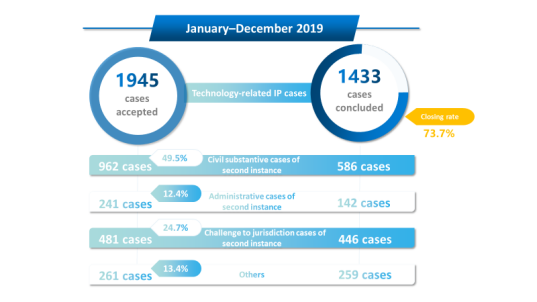
(1) Statistical analysis of the cases
① Statistical analysis of the source of cases
In 2019,the IP Court accepted a total of 1,684 various types cases of second instance. Among them, 1,678 were appealed against judgments made by Intermediate People’s Courts in the first instance, accounting for 99.6%; and 6 were appealed against judgments made by High People’s Courts in the first instance, accounting for 0.4%.
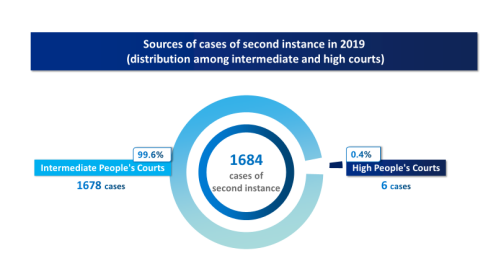
In terms of the source regions of the cases, the top ten include: Beijing Intellectual Property Court (376 cases), Guangzhou Intellectual Property Court (297 cases), Shanghai Intellectual Property Court (143 cases), Nanjing Intellectual Property Tribunal (107 cases), Shenzhen Intellectual Property Tribunal (96 cases), Ningbo Intellectual Property Tribunal (85 cases), Suzhou Intellectual Property Tribunal (71 cases), Hangzhou Intellectual Property Tribunal (70 cases), Qingdao Intellectual Property Tribunal (67 cases), and Jinan Intellectual Property Tribunal (53 cases). The above data roughly reflect the distribution of technology-related IP disputes across the country. It is clear from the above data that economically developed regions tend to have more economic activities involving technology-related intellectual property and accordingly, there are more related disputes.
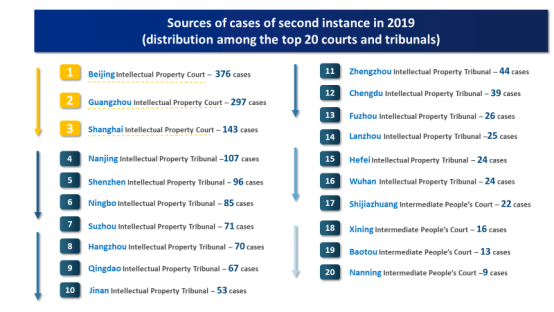
②Statistical analysis of the types of cases accepted
Among the 962 civil substantive cases of second instance accepted by the IP Court, there were 454 disputes over infringement of utility model patent rights, 234 disputes over infringement of invention patent rights, 142 disputes over computer software, 40 disputes over patent agency and licensing contracts, 26 disputes over technical contracts, 20 disputes over new plant variety rights, 12 disputes over technical secrets, 9 disputes over monopoly, 9 disputes over patent application rights and patent ownership, 8 disputes over confirmation of non-infringement, 7 disputes over remuneration to service inventors, and 1 dispute over layout design of integrated circuits. The majority of the cases are disputes over infringement of utility model patent rights (47.2%), disputes over infringement of invention patent rights (24.3%), and disputes over computer software (14.8%).
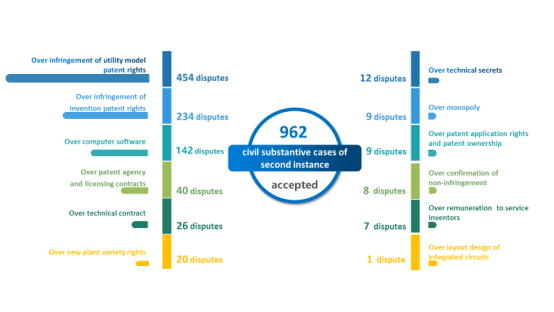
Among the 241 administrative cases of second instances accepted by the IP Court, there are 230 cases of administrative grant and affirmation, 7 administrative penalty cases, and 4 other administrative cases. Among the cases of administrative grant and affirmation, there are 80 administrative disputes over invalidation of patent rights, 71 administrative disputes over reexamination of invention patent applications, 57 administrative disputes over invalidation of utility model patent rights, 9 administrative disputes over reexamination of utility model patent applications, and 13 administrative disputes over invalidation of design patent rights. The majority of the cases are administrative disputes over invalidation of invention patent rights (33.2%), administrative disputes over reexamination of invention patent applications (29.5%), and administrative disputes over invalidation of utility model patent rights (23.7%).
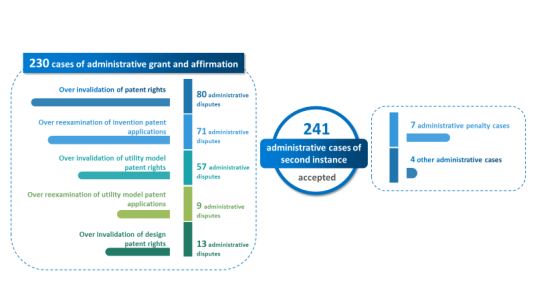
③ Statistical analysis of judgment results
In 2019, the IP Court concluded a total of 1,174 cases of second instance. Among them, 731 cases were concluded with the decisions of the first instance being affirmed; 280 cases were concluded with the appeals being withdrawn, 71 cases were concluded through mediation, with the mediation and withdrawal rate of 29.9%; and 92 cases were concluded by either being sent back for retrial or reversal of decisions on appeal, with the send back and reversal rate of 7.8%. Of the 92 send back for retrial or reversal cases concluded by the IP Court, there were 66 civil substantive cases of second instance, 21 cases of second instance on challenge to jurisdiction, and 5 administrative cases of second instance.

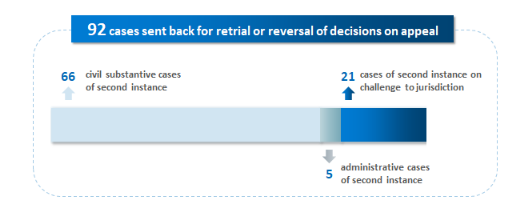
Of the 586 civil substantive cases of second instance concluded by the IP Court, 236 were concluded with the decision of the first instance being affirmed; 213 cases were concluded with the appeals being withdrawn, 71 cases were concluded through mediation, with the mediation and withdrawal rate of 48.5%; and 66 cases were concluded by either being sent back for retrial or reversal of decisions on appeal, with the send back and reversal rate of 11.3%.
Of the 142 administrative cases of second instance concluded by the IP Court, 126 cases were concluded with the decision of the first instance being upheld; 11 cases were concluded with the appeals being withdrawn; and 5 cases were concluded by reversal of decisions on appeal, with the reversal rate of 3.5%.
Of the 446 cases of second instance on challenge to jurisdiction concluded by the IP Court, 369 cases were concluded with the decisions of the first instance being affirmed; 56 cases were concluded with the appeals being withdrawn; and 21 cases were concluded by reversal of decisions on appeal, with the reversal rate of 4.7%.
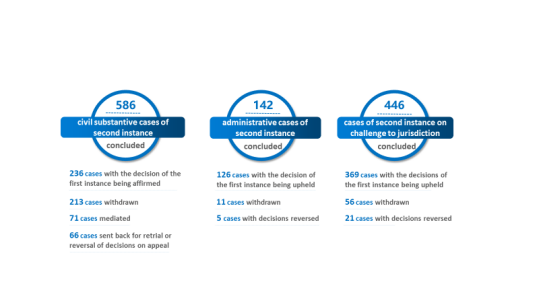
④ Statistical analysis of trial period
In 2019, the average trial period for substantive cases of second instance tried by the IP Court was 73 days, and 29.4 days for cases of second instance on challenge to jurisdiction. The closing rate was 39.2 cases per judge.
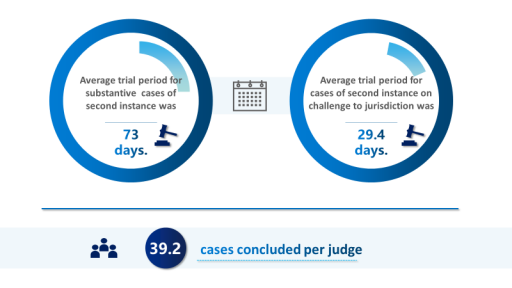
⑤ Statistical analysis of cases involving a party from foreign country, Hong Kong, Macau, and Taiwan Region
In 2019, the IP Court accepted 174 cases involving a party from foreign country, Hong Kong, Macau, and Taiwan region. Among them, there were 50 civil substantive cases of second instance, 52 administrative cases of second instance, 71 cases of second instance on challenge to jurisdiction, and 1 other case. By region, there were 75 cases involving EU countries, 54 cases involving the United States, 15 cases involving Japan, 4 cases involving South Korea, 2 cases involving Canada and Israel, respectively, 1 case involving Australia and South Africa, respectively, and 20 cases involving Hong Kong, Macau and Taiwan.
The IP Court concluded 98 cases involving a party from foreign country, Hong Kong, Macau, and Taiwan region. Among them, 35 substantive cases were concluded, of which 21 were won by foreign parties (including partially won), 3 were won by Hong Kong, Macao and Taiwan parties, and 11 were won by parties of the Chinese mainland.
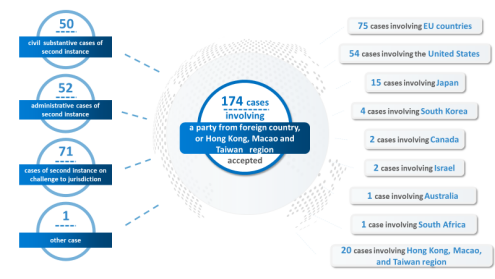
(2) Case characteristics analysis
① Overall characteristics of cases
In 2019, technology-related IP cases tried by the IP Court share the following characteristics: they involve a wide range of technologies; they have a large social impact; many of them involve interconnected procedures; the trial period is short; the legitimate rights and interests of Chinese and foreign parties are equally protected; and the direction for increasing the judicial protection is clear.
(i) The cases involve a wide range of technologies. The types of intellectual property rights claimed by the parties involve many fields that are closely related to national economy, people’s livelihood, cutting-edge technology, clothing, food, housing, and transportation, including medicine, gene, telecommunications, machinery, agriculture, and forestry.
(ii) The cases have a large social impact. One is the high market value of the intellectual property involved in the cases. There are 17 cases of first instance in which the obligee claimed infringement damages of over RMB 10 million, including 3 cases with claims over RMB 100 million. Two is the high degree of attention from society when the cases involve cutting-edge technologies or national economy and people’s livelihood, such as standard essential patents (SEPs), pharmaceutical patents, etc.
(iii) The cases involve interconnected procedures. The IP Court accepted many mutually competitive litigation cases where the parties file multiple civil and administrative litigations against each other in different courts. There were many related cases involving different trial levels and different procedures. The IP Court achieved good results by coordinating and handling the cases from the aspects of trial procedures, judgment standards, holistically mediation, etc., and the percentage of mediation and withdrawal rate of second instance cases concluded in 2019 was 29.9%.
(iv) The trial period of the cases is short. Due to various factors such as interconnected civil and administrative procedures, and difficulty in finding technical facts, the trial period for technology-related IP cases is generally longer. However, the average trial period for substantive cases of second instance concluded by the IP Court in 2019 was only 73 days, which indicated that the trial period for cases involving the protection of technology-related intellectual property rights had been considerably shortened.
(v) The legitimate rights and interests of Chinese and foreign parties are equally protected. The cases involving a party from foreign country, Hong Kong, Macau, and Taiwan region accounted for 8.9% of all cases accepted by the IP Court. Some of the cases were part of transnational litigation between the parties, which interplayed with foreign patent infringement litigation and together constituted an integral part of the parties’ business competition strategy. The IP Court continues to insist on equal treatment and equal protection of the intellectual property rights of both Chinese and foreign market entities of various types, according to law.
(vi) The direction for increasing the judicial protection is clear. A good-faith litigation mechanism is adopted and in the event of refusal to perform an order on presenting documents, intentional damage to the product in preservation, etc., a presumption of fact against the actor is taken. Among the cases concluded, cases supporting the obligee’s claims according to law, account for 61.2%.
② Characteristics of civil patent cases
The civil patent cases heard by the IP Court have the following characteristics:
(i) There are many cases where claim construction and the determination of equivalent infringement are the main disputes. Since claim construction is related to the determination of the scope of protection of patent rights and the result of comparing infringing technologies, through the judgment in individual case, the IP Court conducts in-depth exploration of the identification criteria of functional features, the limitation of subject names on the protection scope of the claims, and the application of the dedication doctrine. As there are many cases involving the judgment of equivalent infringement, how to maintain the publicity function of patent claims while granting fair protection to patent holders becomes the main difficulty in hearing such cases.
(ii) The legitimate source defense, the prior art defense, and the preemption defense are the most common defenses. Cases where the legitimate source defenses are proposed, account for the largest proportion, and most of the disputes focus on the distribution of burden of proof and the scope of exemption from liability for damages. The prior art defense is relatively arbitrary, and parties who file or present the prior art defense for the first time during the second-instance procedure, account for a large proportion.
(iii) Related cases with commercial rights protection account for a certain proportion. In such cases, the obligee carries out large-scale and centralized commercial rights protection across the country with the same patent. Most of the patents involved are utility model patents that have not been substantively examined, and most of the alleged infringers are small downstream vendors in the goods supply chain.
③ Characteristics of administrative cases concerning patents
The administrative cases concerning patents heard by the IP Court have the following characteristics:
(i) There are many cases involving invention patents and high-tech fields.Among the three types of patents, invention patents are the most technical, and invention patent cases rank first among declaration of invalidity cases and reexamination cases, reflecting the importance attached to patent value by inventors and the relevant public. In terms of the technical field, most number of cases involves the mechanical field, but among declaration of invalidity cases, cases in the electrical field and the mechanical field account for the most number. There are also many disputes in high-tech fields such as telecommunication technology and computers. Although the total number of declaration of invalidity cases is small in the chemical field, they are generally concentrated in important industries such as pharmaceuticals and biotechnology.
(ii) Judgment of inventiveness is the main dispute in most cases. There were a total of 92 cases involving inventiveness judgment, accounting for about 70% of patent administrative cases, and among the cases where the judgment of the first instance was reversed, 80% involve examination of inventiveness. In the trial of such cases, the IP Court judges attach importance to determination of non-obviousness by using the “three-step approach”, standardize auxiliary considering factors such as commercial success, and explore judgment of inventiveness concerning compound medicines in new crystalline form, preserved biomaterials, etc., so as to ensure that truly valuable inventions are protected according to law.
(iii) Among the cases sent back for retrial, many cases have natural persons as the applicants. Of the 57 reexamination cases, 75% of the cases have natural persons as the applicants. Most of them were dismissed due to lacking of inventiveness, and a few lacking of either practical applicability or patent subject matter eligibility. The applicants were natural persons in 10 cases where the cases were not accepted due to a misunderstanding of the calculation method for the time limit of litigation filing in patent administrative litigation.
④Characteristics of cases concerning computer software
Cases concerning computer software heard by the IP Court have the following characteristics:
(i) The types of the cases are relatively concentrated. There are mainly two types of software cases: contract cases and infringement cases and the former accounts for over 80% of its total number.
(ii) The focus of the disputes is relatively concentrated. In particular, software contract cases mainly focus on whether the software are developed and delivered, whether the software developed meets the agreement, whether the parties have agreed on the changes in performing the contract, and whether there is delay in performance, etc.
(iii) The difficulty of settlement varied greatly. In software infringement cases, if there is an argument about the technical facts of infringement, complex comparison of the source program, which proves difficult, is usually necessary between the allegedly infringing software and the copyrighted software; if no such argument occurs, the case is easy to solve. In software contract cases, if the agreement terms are vague or the performance standards are not well defined in the contract, the case is difficult to solve; otherwise, it proves easy.
⑤Characteristics of cases concerning jurisdiction
Cases concerning jurisdiction heard by the IP Court have the following characteristics:
(i) The number is large. Based on the litigation strategy, the complexity of jurisdictional rules, and the existence of more jurisdictional connection points, the alleged infringer has more arguments to challenge the jurisdiction in IP cases.
(ii) There are many new issues with great difficulties. These issues include whether the arbitration clause in the agreement applies to the jurisdiction of monopoly agreement disputes; whether the place where a monopoly agreement is reached can be considered as the connection point for the jurisdiction of monopoly disputes; can the network platform provider be taken as the connection point for jurisdiction in cases where the vendor is not sued; whether the place where the act of infringement is committed claimed by the patent owner can be the connection point for jurisdiction in the disputes over confirmation of non-infringement, etc. These issues reflect that with the continuous development of technology, business models, and rights protection practices, the jurisdiction of technology-related IP cases has become increasingly complex and diverse.
(iii) The judicial position is relatively lenient. Of the 446 cases of second instance on challenge to jurisdiction concluded by the IP Court, only 21 were concluded by reversal, accounting for 4.7%. In order to protect the obligee’s in exercising its litigation rights according to law and to moderately promote judicial competition, the IP Court has a more lenient judicial position towards the obligee’s choice of connection point of jurisdiction and respects the olibgee’s right to choose the court of dispute jurisdiction.
⑥ Characteristics of other types of cases
Cases concerning new plant variety rights heard by the IP Court have the following characteristics:
(i) The varieties involved are closely related to people’s daily lives, such as corn, rice, honey pomelo, flowers, etc.
(ii) The identification of technical facts is more difficult, and it is especially difficult to determine the “identity.”
(iii) The legal issues involved in the cases are diverse, such as the standing of parties in the litigation, the scope of protection of variety rights, the defense of legitimate sources, and the amount of damages, etc.
Most of the technical contract cases heard by the IP Court take the review and judgment of breach of contract as the focus of the trial, and the technical fact finding has a major impact on the determination of breach of contract.
The cases concerning technical secret heard by the IP Court involve many procedural issues, through which the IP Court has further clarified the procedural rules.
2. Create model cases with typical exemplary effect
Judgments rendered by the IP Court are judgments of the Supreme People’s Court, and are final and authoritative. The IP Court comprehensively leverages its centralized jurisdiction over technology-related IP cases of second instance to create model cases with typical exemplary effect, social influence, and uniform legal application standards.
On March 27th, 2019, the collegial panel of the IP Court consisting of Chief Judge Luo Dongchuan and Deputy Chief Judge Wang Chuang “struck the gavel for the first time” when they tried in public the first technology-related IP case—an invention patent infringement dispute of Xiamen Lukasi Automobile Parts Co., Ltd. and Xiamen Fuke Automobile Parts Co., Ltd. (Appellants) v. VALEO SYSTEMES D’ESSUYAGE (Respondent). From filing time of this second instance case to court hearing, closing and service of judgment, the IP Court took only 50 days. The case involved a frontier issue of preliminary judgment on patent infringement. Through this case, the IP Court clarified the criteria for determining functional feature, the unique value of the preliminary injunction when the preliminary decision involving the permanent injunction has not yet taken effect, and the applicable conditions and rules when the preliminary injunction and the preliminary judgment involving permanent injunction coexist. The case was identified as a guiding case by the Supreme People’s Court, and included in the “Top Ten Model Civil and Administrative Cases in 2019”.
Taking “this first gaveled case” as a model, the IP Court summarized its experiences from individual cases to try similar cases based on the characteristics of intellectual property in different technical fields, and established a number of model cases. For example, in the field of machinery, the invention patent infringement case of Wuxi Hisky Medical Technologies Co., Ltd. (Appellant) v. Echosens (Respondent) and China-Japan Friendship Hospital (Defendant in the first instance) was tried by the IP Court. The patent involved was that of a “non-invasive diagnostic instrument for liver disease.” The case established the rules for claim construction in patent infringement litigation, the distribution of burden of proof and the determination of the literal and equivalent infringement. In the field of pharmaceuticals, an administrative reexamination dispute over invention patent of the National Intellectual Property Administration, PRC (Appellant) v. Erasmus University Medical Center Rotterdam and Roger Kingdon Craig (Respondents) was tried by the IP Court. The IP Court clarified the relationship between the patent inventiveness examination and the full disclosure of the specification and other legal standards, promoted the inventiveness examination standards to return to the core and essence in patent examination, and gave clear guidance on how to avoid "hindsight" in the inventiveness examination. In the field of telecommunications, the invention patent infringement case of Shenzhen Jixiang Tenda Technology Co., Ltd. (Appellant) v. Shenzhen Dunjun Technology Co., Ltd. (Respondent) involved the patent for “a method for easy access to a portal website of a network operator”. This case, taking the technical characteristics of the network telecommunication field as an important consideration, set up a new adjudication rule on multi-actor method patent infringement, that is, if the alleged infringer, without the patentee’s permission, realizes the substance of the patented method of the allegedly infringing product for the purpose of production and operation, and plays an irreplaceable and substantial role in the comprehensive coverage of the technical features of the patent claims; then in such a case, it should be held as an infringement on the method patent. In the field of new plant varieties, the case of dispute over new plant variety rights of Cai Zinguang (Appellant) v. Guangzhou Runping Commercial Co., Ltd. (Respondent) involved a “three red pomelo” new plant variety. The case established the adjudication rules on the scope of protection of new plant variety rights and the determination of an infringement. It established that where the plant is both propagating and harvested material, the true intention of the allegedly infringing seller to sell it as a propagating material or harvested material should be examined.
3. Implement a systemization project to unify judicial standards
Over the past year, the IP Court has built and implemented the “systemization project to unify judicial standards”, and established a working system with special standards, subsection guarantees, and strict management of key points, providing institutional and system guarantees for the unified judicial standards for technology-related IP cases.
With respect to system development, the “Implementation Rules for Unifying Judicial standards of the IP Court” was formulated, which clarifies and distributes cases involving the same patent to the same judge or collegial panel in principle, to ensure the uniformity of judicial standards. With respect to front-end sorting, multiple measures such as system comparison and manual review have been adopted to identify similar cases. Civil cases involving the same patent, interconnected civil-administrative cases, and cases with related parties, are collectively allocated to the same collegial panel. With respect to mid-end control, the judge meeting system has been improved. The IP Court held 34 judge meetings throughout the year, unified 120 adjudication rules, and issued the Excerpts from the Minutes of Judge Meetings and Tips for Handling Cases, so that judges can master important judicial standards and case handling methods in a timely manner. Using platforms such as “The IP Court Forum” and “The New Knowledge Lecture Hall,” the IP Court managed to establish adjudication consensus within the IP Court. It also organized “The IP Court Work Deployment and Professional Training Courses” and “Adjudication Practice Training Courses for Technical Cases in People’s Courts,” to strengthen transmission of guidance and adjudication rules to the lower courts. With respect to back-end review, the judge meetings have been used to check the judgment documents of model cases and major sensitive cases. A document evaluation system has been set up to improve the quality of judgment documents. With respect to key cases, a special case report and guidance mechanism for major cases has been established, with 28 Work Information of the IP Court issues and special issues being compiled and distributed, to provide references for leadership decisions.
Ⅱ. Deepen institutional reform, promote intelligent case handling, and further improve the quality and effectiveness of technology-related IP case trials
As the first specialized judicial institution established at the highest court level in the world to handle nationwide patent and other technology-related IP appeals, the IP Court is determined to forge ahead, act as a pioneer and explorer for reform, innovate systems and mechanisms, promote informatization, strengthen team capabilities, and take comprehensive and multiple measures to improve the quality and effectiveness of technology-related IP case trials.
1. Leverage institutional strengths and innovate the trial mechanism
The IP Court aims to protect innovations in an innovative manner and promotes reform with a reform mindset. Over the past year, it has achieved several breakthroughs and innovations in the litigation system for technology-related IP cases.
Implement a centralized and unified jurisdiction system and a “Leapfrog Appeal” system with Chinese characteristics. According to the Decision of the Standing Committee of the National People’s Congress on Several Issues concerning Judicial Procedures for Patent and Other Intellectual Property Cases, nationwide civil and administrative appeals involving technology-related intellectual property are tried under the unified jurisdiction of the IP Court. Whether the first-instance judgment of a technology-related IP case is made by an Intermediate People’s Court or a High People’s Court, all appeals are handled by the IP Court. In terms of the technology-related IP appeals against the first instance judgment made by an Intermediate People’s Court, a “Leapfrog Appeal” system with Chinese characteristics has been created. The appeals leapfrog a High People’s Court from an Intermediate People’s Court to the Supreme People’s Court. This not only helps to unify judicial standards and shorten the duration of dispute resolution, but also highlights the judicial policy and adjudication rules for technology-related IP cases at the highest judicial level in China.
Explore a collaborative trial mechanism for civil and administrative cases involving the same patent. China’s patent system adopts a dual system for civil infringement procedures and administrative invalidation procedures. Problems arising from the implementation of this system are: on the one hand, civil infringement procedures concerning patents are often affected and constrained by the administrative invalidation procedures, and the overlapping procedures results in longer time required for patent protection and relapsed results; on the other hand, patentees can use separate procedures to make different claim constructions by arguing for a limited scope of protection in administrative invalidation procedures to obtain affirmation and an expanded scope of protection in civil infringement proceedings to obtain an advantage in the determination of infringement, thus the patentee can “profit from both sides.” With the support of Beijing Intellectual Property Court and other local courts, the IP Court has taken full advantage of its centralized jurisdiction, and established a collaborative advancement mechanism for civil and administrative cases involving the same patent, to synergize the determination of the patent validity and the determination of infringement, thus resolving the problem of long period for patent litigation and the plaintiff’s inconsistent claim constructions for the same patent in different cases at the mechanism level. The specific approach is that the IP Court collects the information of the cases involving the same patent and forwards it to the Beijing Intellectual Property Court, to coordinate the trial process and to unify the judicial standard. For cases that have entered the second-instance stage, the IP Court actively utilizes the trial mechanism to solve the problems arising from the dual system under the current legal framework, on the basis of “front-end sorting.” For example, the patent invalidation administrative dispute and infringement dispute of Lejin Electronics (Tianjin) Electrical Appliance Co., Ltd. v. Xiamen Power Electronic Technology Co., Ltd. involved the same patent. The IP Court established the same collegial panel and appointed the same technical investigators to convene a pre-trial meeting, focused on the claim construction issues involved in both cases, and recorded them in the judgment document. By doing so, a bridge of communication between the administrative litigation and the civil litigation is built, which enabled coordination of judicial standards for the civil litigation concerning patent infringement and the administrative litigation concerning patent invalidation.
Develop a “1+76” model for technology-related IP case trials and establish an integrated coordination mechanism. There are 32 High People’s Courts and 44 Intermediate People’s Courts in China that have jurisdiction over technology-related IP cases of first instance. A preliminary “1 + 76” model for technology-related IP case trials with the IP Court as the appellate body has been developed to ensure overall planning and nationwide concerted efforts, and to gradually exert the advantages and overall effectiveness of an integrated coordination mechanism. Over the past year, the IP Court has utilized the integrated coordination mechanism to expand dispute resolution channels and mediate 80 patent infringement cases across regions, and has achieved satisfactory results by “closing cases before the court session begins and resolving disputes before the relevant parties depart.” For example, in the invention patent infringement case of Tong Yonghua and Ningbo Zhaohua Environmental Technology Co., Ltd. (Appellants) v. Yuyao Pude Water Equipment Factory, et al. (Respondents), the IP Court found out that the parties involved had other outstanding cases in different regions and courts with respect to the same patent and other relevant patents; the IP Court then contacted Hangzhou IP Tribunal and Ningbo IP Tribunal. These three courts at three regions and two levels coordinated, cooperated, and jointly participated in the mediation and settled eight cases with one package solution. In the invention patent infringement case of Jiangsu Baodiao Motor Vehicle Co., Ltd. (Appellant) v. Chongqing Yingang Technology (Group) Co., Ltd. et al. (Respondents), with the support of the High People’s Courts in Jiangsu, Sichuan, Chongqing, etc., the IP Court achieved a resolution of 7 cases of first-instance, second-instance and retrial, across regions and procedures.
Implement a nationwide circuit trial system. Insisting on putting the people at the center, supported by the 6 Circuit Courts of the Supreme People’s Court and the local courts, the IP Court has explored the circuit trial model of “the IP Court + Circuit Courts”, established a case trial mechanism of “Investigation + Court Hearing”, and arranged circuit trials of the case at the place where the dispute occurred or where the People’s Court of first instance is located, so as to facilitate litigation and promote prompt and on-spot resolution of disputes. Over the past year, the IP Court visited Nanjing, Shenzhen, Jinan, Zhengzhou, Golmud, and other places to conduct onsite investigations on submersible pumps, large screen printing machines, and other large mechanical equipment that are difficult to transport. A total of 23 cases’ onsite investigations and circuit trials were completed, which facilitated the litigation by the public and enriched the intellectual property protection practice of “Fengqiao Experience”. For example, in the case of infringement of utility model patent rights of Dongguan City Topfly Packaging and Printing Co., Ltd. (Appellant) v. Haoda Screen Printing Machinery (Respondent), and Zhuhai Hongsen Circuit Board Co., Ltd. (defendant in the first instance), since it was inconvenient to transport the alleged infringer’s large screen printing machine, and as the alleged infringer had appealed that the court of first instance did not separately compare the 50 technical features included in the patent claim 1 involved, the collegial panel decided to visit the factory in Zhuhai to compare the suspected infringements. The case was heard in public at the First Circuit Court of the Supreme People’s Court in Shenzhen. Finally, the Appellant’s appeal was supported on the basis of ascertained technical facts.
Improve the technical fact finding mechanism. First, the IP Court has led the preparation of the “Database of Technical Investigators and Technical Consulting Experts for Chinese Courts,” bringing together more than 360 technical investigators and technical consulting experts from all over the country, covering more than 30 technical fields. These include technical investigators employed by the People’s Courts, as well as technical investigators and technical consulting experts from China National Intellectual Property Administration, scientific and technological enterprises, universities, research institutes working as exchange personnel, part-timers, volunteers, etc., which has helped effectively solve the problems of single source, unbalanced distribution in fields, and insufficient talent supply. Second, the IP Court has established a “Technical Investigation Resource Sharing Mechanism for Chinese Courts,” adopted the Several Provisions of the Supreme People’s Court on Technical Investigators’ Participation in Legal Proceedings of Intellectual Property Cases, and has promoted the on-demand deployment of technical investigators nationwide or dispatching of technical consulting experts based on the Several Provisions. The sharing mechanism and the database work together to enable technical investigation talents to be dispatched on demand throughout China based on unified deployment, maximizing the effectiveness of existing resources. In July 2019, the IP Court deployed a technical investigator in the mechanical field, at the request of the Intermediate People’s Court of Yinchuan of Ningxia Hui Autonomous Region, to participate in the trial of a patent infringement case of a “no-tillage double-furrow all-plastic-film mulching and earthing combined machine”. In November 2019, the IP Court, at the request of the Tianjin IP Tribunal, took into account the overall situation with respect to the region, field, personnel, etc., and deployed a technical investigator in the field of biomedicine from the Beijing Intellectual Property Court through the “Database of Technical Investigators and Technical Consulting Experts for Chinese Courts”, to participate in the patent infringement case trial for “1L1RL-1 as a cardiovascular disease marker and therapeutic target”. In December 2019, Nanjing IP Tribunal proactively arranged its technical investigator in the computer software field to facilitate the IP Court in handling of a computer software copyright infringement case, in which the complicated source-code-related facts were correctly ascertained, and hence the parties settled their dispute through mediation in a sound way on the basis of the newly ascertained technical facts. Third, to solve the practical problems that exist, such as the difference in work and knowledge cognition habits of technical investigators, inconsistency in litigation details, and other issues, the IP Court took the lead in organizing three Intellectual Property Courts in Beijing, Shanghai, and Guangzhou, and the IP Tribunals in Tianjin, Shenzhen, Nanjing, Suzhou, and other places, to jointly compile and publish the Work Manual of Technical Investigators (2019). The manual provides work guidelines and standards for technical investigators of Chinese courts, with respect to ascertaining technical facts.
2. Strengthen informatization development and promote intelligent case handling
Information technology is an important means to improve the quality and effectiveness of judicial trials. The IP Court attaches immense importance to the development of information technology and explores the application of new generation of information technology such as big data and artificial intelligence in trial work. Positive progress has been made in terms of database of adjudication rules, technology IP Court, remote cross-examination, etc., and overall planning has been made for future informatization development.
First, establish a new database of adjudication rules focused on specific rules for the application of law. The first batch of adjudication rules that came online have come from the guiding cases of the Supreme People’s Court, the annual reports on intellectual property of the Supreme People’s Court, the typical cases of Chinese courts, and the guiding cases concluded in 2019 by the IP Court that were extracted and written by the judges of the IP Court. These were then systematically sorted out and classified. Users can input keywords in the database to obtain related adjudication rules in the form of “mind map of rules” and “list of rules.” These two formats are constructed according to the legal logic and the characteristics of the types and fields of the cases, presenting a systematic knowledge structure that differs from the usual simple enumeration format, and can guide users to actively learn and master related rules. The database can be used not only to assist judges in hearing similar cases, but also to test the quality of trials. At present, the trial version of the adjudication rules database has been completed and will be formally made operational soon, providing strong support for intelligent trial of technology-related IP cases by Chinese courts.
Second, build a technology IP Court that combines the use of information terminals, synchronized marking technology, AR technology, voice recognition technology, electronic signature technology, etc.
During the court’s session, the information terminal of the bench is connected to the case handling system, so that judges can access the electronic files. The terminal has an embedded synchronized marking technology. During the cross-examination process, both the judges and the relevant parties can simultaneously mark the evidence with different colored lines and highlights, using their respective terminals. The technology IP Court can also use AR technology. Using AR glasses, the circuit layout and other small and high precision evidence can be projected on the large screen, making it easy to view minute structures. The voice recognition technology and electronic signature technology of the technology IP Court can convert voice into text to generate court records in real time, and replace traditional signatures with e-signatures, respectively. Each page of the court records is signed with just one e-signature.
Third, use remote high-definition video transmission technology for remote cross-examination. For evidence that cannot be easily transported, the IP Court conducts remote cross-examination using remote high-definition video transmission technology. In the case of infringement of invention patent rights of Beijing Reci Laser Technology Co., Ltd. and Shanghai Rongdong Laser Technology Co., Ltd. (Appellants) v. Shanghai Jiading Malu Dongfang Laser Tube Factory (Respondent), the alleged infringing product was a fragile glass product, which could not be easily transported over a long distance. The IP Court communicated and collaborated with the court of first instance, i.e., Shanghai Intellectual Property Court, to remotely display and conduct remote cross-examination of evidence in real time.
Fourth, prepare overall plans for future informatization development work. The IP Court formulated the Three-year Development Plan for the Intelligent Construction of the IP Court (2019-2021), which clarified the goals and ideas of informatization development. The Plan proposed the concept of “one platform”, “two services”, “three scenarios”, “four connections”, and “five key projects”, to create an intelligent case handling system for the IP Court that is safe and controllable, supports comprehensive coverage, interconnection, cross-border integration, in-depth application, and is transparent and convenient. “One platform” refers to the IP Court’s electronic litigation platform, which provides a full range of intelligent services for judges, litigants, and the public. “Two services” refers to insisting on serving the people and serving the trial work. “Three scenarios” indicates that the results of informatization development are reflected in three scenarios: litigation service, the technology IP Court, and the big data analysis platform. “Four connections” refer to connecting the relevant lower courts, external units, parties, and the public. “Five key projects” include the adjudication rules database, the big data analysis platform, the external data interaction platform, the two-level collaboration platform & remote court hearing system, and the IP Court cloud.
3. Strengthen team building and enhance judicial capacity
Team building is the foundation and guarantee for stable and long-term development of the judiciary. Technology-related intellectual property case trials have the characteristics of professionalism, cutting-edge technology, and international scope. The judges must have a firm political position, exceptional professional capabilities, and be prudent and honest, to effectively improve judicial capacity and become the talent guarantee for improving the quality and effectiveness of trials.
The IP Court has 8 collegiate panels, a litigation service center, and a general office. The IP Court has totally 140 staff members, 42 of whom are judges, all of them possessing a master’s or above degree. Among them, 37.5% have doctoral degrees, 22.5% have a background in science and engineering, and 17.5% have overseas study experience. Some judges are selected from the Supreme People’s Court, most of the judges are seconded from local courts across the country that have mature experiences in patent trials, and three other judges are exchange judges from China National Intellectual Property Administration. After several rounds of selection, the IP Court’s trial team consists of elite judges, selected in a way like “screening an army on the battleground” across the country. The IP Court takes full advantage of its talents and has further strengthened team building while maintaining high standards and strict requirements, by utilizing multiple channels. It has strived to forge a trial team possessing a firm political position, with members who are upright and honest, proficient in the law, familiar with technology, possess knowledge of China’s national conditions, and have an international perspective.
First, strengthen political development and enhance team cohesion.Guided by the Xi Jinping Thought on Socialism with Chinese Characteristics for a New Era, the IP Court has enhanced the “Four Consciousnesses”, fostered the “Four Matters of Confidence”, and ensured “Two Upholds”, to insist on absolute leadership of the CPC over the people’s courts, to ensure that the Central Committee’s decisions and plans in the IP Court are carried out without compromise, and ensure the right political direction of the intellectual property trial work. The IP Court has implemented the general requirements for Party building in the new era, comprehensively improved the team’s quality and capabilities, chosen the right direction for the selection and employment of personnel, promoted righteousness and strived for excellence, and has fully mobilized the enthusiasm, initiative and creativity of all staff members, and encouraged the staff members of the IP Court to take on new roles and new actions in the new era and new environment.
Second, strengthen professional capabilities and enhance the team’s ability to perform duties. Based on active thinking, fast knowledge update, and high degree of internationalization in the field of intellectual property, the IP Court has actively created conditions to specifically strengthen the trainings in intellectual property and foreign language to enhance the team’s ability to perform its duties. Over the past year, two national trial practice training courses were held to provide in-depth explanation of the judicial policy and adjudication rules and promote harmonization in thoughts and coordination in pace among the IP courts and tribunals across the country. The IP Court also held multi-level professional trainings, built high-quality standardized learning platforms such as the “The New Knowledge Lecture Hall” and “The IP Court Forum,” to invite well-known experts and scholars from across the country to give lectures to the IP Court, and broadcast live to the local courts, to improve the trial team’s professional quality. It established a foreign language working group, carried out daily online and offline foreign language training, and translated foreign court decisions and academic papers on frontier issues. The IP Court has given full play to the pioneering role of its national trial experts, who as the trendsetters can thus be followed by the other staff members of the IP Court, and is striving to become an education base for the IP courts and tribunals across the country to forge the professional technical trial team of Chinese courts.
Third, strengthen integrity and forge a team with excellent work style. On the one hand, based on the actual trial work, the IP Court has managed to explore and establish the Party building work method of “full online and offline coverage, and round-the-clock education and management” with the help of new media. By utilizing interactive online micro-platforms for information dissemination on different themes such as “House of Party Members”, “Learning, Thinking, Practicing and Comprehending”, “Do You Know?”, and offline learning & education platforms such as the “Party Building” promotion gallery, and based on multichannel coverage approach, youthfulness, and interactivity, the IP Court has successfully built a Party building learning platform. It has made the learning content close to the actual work, utilized interactive Q&A and mutual teaching and sharing methods to evaluate the learning result, and has created a well-accepted Party building brand that was listed among the “One Hundred Excellent Cases” at the 2nd Party Building Innovation Achievement Selection Activity organized by Flag of the State Organs Work Committee of CPC Central Committee. On the other hand, it has established the “1 + N” system with the Opinions of the IP Court on Strict Governance of the IP Court to Prevent Risks, as the guiding principle, and established more than 50 regulations. The IP Court adopts innovative forms, such as sending “Intellectual Property Letters to Homes of All Staff Members”, to enhance the execution and binding power of the aforesaid regulations and promote the formation of a clean and honest governance ecosystem.
Ⅲ. Promote judicial openness and carry out international exchanges to further promote judicial trustworthiness and international influence
Against the background of comprehensively building a society governed by law and advancing the modernization of the judicial system and judicial capacity, society has extremely high requirements for judicial openness in terms of both the breadth and depth. The establishment of the IP Court has attracted the attention of the society and the world. It needs to uphold a high degree of consciousness and a noble sense of mission, to actively promote judicial openness and participate in international exchanges, so that the IP Court’s system and practices in judicial protection of technology-related intellectual property can be comprehensively and objectively understood both home and abroad.
1. Deepen judicial openness and enhance judicial trustworthiness
Focusing on the goal “to make people feel fairness and justice in every judicial case”, the IP Court takes judicial openness as the core and judicial publicity as the primary measure, to constantly enhance the transparency of judicial information, and promote improvement of judicial trustworthiness.
With judicial openness as the core, trial information is fully disclosed in accordance with the law. The IP Court utilizes four public platforms built by the Supreme People’s Court, i.e. the China Judicial Process Information Online, tingshen.court.gov.cn, China Judgments Online, and zxgk.court.gov.cn, to realize the full openness of the trial process. In terms of openness of court hearings, the IP Court adheres to the principles of openness and live broadcasting, and considers non-openness as an exception to the rule. Live court hearings can be viewed online in real time, and people can also log in to the tingshen.court.gov.cn website to view the court hearing videos after the court session. Major cases are tried with openness through whole process in order to promote justice with such openness. In terms of the openness of judgments, the IP Court promptly publishes judgments that should be disclosed according to law on China Judgments Online, and regularly counts and reports the status of documents that it has published online. As an effort to boost the public’s awareness of the IP Court’s adjudicative work, all of the adjudicative documents (either written judgments or decisions) as rendered by the IP Court contain the main points of such judgments or decisions, and concisely explain the legal issues involved in the case, plus the opinions and results of the adjudications, so that the relevant parties and the public can clearly understand the results and the basis of the judgments. By doing so, the IP Court gives a clear and rational interpretation of the law, enabling justice to be seen and explained clearly, and highlights judicial civilization and justice.
Comprehensively show the work of the IP Court while focusing on judicial publicity. On March 27th, 2019, after the gavel was struck for the first time at the IP Court, the IP Court opened a court session. Through full-media live broadcasts and extensive reporting by dozens of media including CCTV, the online live broadcast of court hearings received more than 18 million views for the first time. In late April, the IP Court held several activities such as “Public Open Week,” “Court Hearing Week of IPR Protection,” and “Judges to Campus,” inviting people from all walks of life and journalists to visit the IP Court, to experience the intelligent systems such as submission of electronic litigation materials, online search for typical cases, and to attend public court hearings. Judges were invited to visit universities such as Tsinghua University, Renmin University of China, North China University of Technology, etc., to introduce the basic situation of the IP Court and the development of judicial protection of intellectual property in China. From December 9th to 13th, the IP Court carried out the “Judgment Week” activity and pronounced judgments on 6 cases that are of demonstration significance. People from industry who attended said: “Through the hearing, I felt the professionalism and objectivity of the trials conducted by the IP Tribunal.” The IP Court also made full use of its Chinese and English official websites and the WeChat public account to publish all kinds of judicial information in a timely manner. A total of 390 manuscripts were published, which were viewed 16.012 million times.
2. Carry out international exchanges and enhance international influence
The IP Court learns from successful international practices in protecting intellectual property rights through international exchanges, and at the same time tells the world the story of China’s efforts in protecting intellectual property by law, thereby contributing Chinese wisdom to the world’s rule of law and civilization. During the year, the IP Court conducted a total of 32 foreign exchange activities, including 18 incoming exchange visits, 8 outgoing exchange visits, and 6 foreign-related activities in China.
First, strengthen exchanges, mutual learning, and “bringing in,” to comprehensively showcase the national goal of strict protection of intellectual property rights. Since its establishment, the IP Court has insisted on deepening international exchanges and cooperation in intellectual property. It has hosted visits by a number of organizations and has held intensive discussions with their delegates, such as from the World Intellectual Property Organization (WIPO), the International Association for the Protection of Intellectual Property (AIPPI), the American Intellectual Property Law Association (AIPLA), the US-China Business Council (USCBS), and the International Court of Justice (ICJ). Francis Gurry, the Director General of WIPO sent a video message congratulating the IP Court on its inauguration, and stated that the establishment of the IP Court “embodies China’s solemn commitment to intellectual property protection and expresses China’s strong determination in the provision of more just and efficient judicial protection for intellectual property.” Craig Allen, President of USCBC said during his visit that the establishment of the IP Court “is of great significance for creating an international, market-oriented and rule-of-law business environment.” Lisa Jorgenson, Executive Director of AIPLA said during her visit that, “The IP Court has very high-quality judges, so the trial of cases will be very effective and comprehensive, and this will have a great impact on the consistency of future judgments.” Abdulqawi Ahmed Yusuf, President of ICJ said during his visit, “International intellectual property experts and lawyers will pay close attention to the judgments made by the IP Court…Surely, the IP Court will have its own judgments on hot controversial issues in intellectual property, such as accessibility of pharmaceuticals and compulsory licensing, relevant market definition in monopoly cases, the balance between the patentee, the patent users, and social public interest, etc. I believe that developing countries will pay particular attention to China’s role in the above-mentioned issues and the approach it has taken.” Rubén Remigio Ferro, President of People’s Supreme Court of Cuba said during his visit, “Each division of the Supreme People’s Court conducts special data processing of various types of cases for summarizing and retrieval, which is worthy of learning. It is commendable that with the use of information technology, these high-tech technologies are used by the IP Court to help judges make more proper judgments in high-tech cases. This is a very good application.”
Second, have an international perspective and “go out” to tell the world the story of China’s efforts in protecting intellectual property based on law.The IP Court actively participates in international exchange activities, demonstrates China’s achievements in the judicial protection of technology-related intellectual property, promotes China’s concept of judicial protection of technology-related intellectual property, and strives to raise international awareness, understanding and recognition of China’s intellectual property protection. It also contributes Chinese wisdom and Chinese solutions to the formulation of international rules on intellectual property rights. In May 2019, a delegation of 8 Chinese patent judges led by Wang Chuang, Deputy Chief Judge of the IP Court, visited France, Luxembourg, and Germany for theme-based exchanges on technology-related IP case trials. They introduced the establishment of the IP Court and the innovative development of China’s judicial system with respect to technology-related intellectual property, to the European intellectual property judicial circles, sending a strong message that China will continue to vigorously strengthen judicial protection of intellectual property rights. In June 2019, Zhou Xiang, Deputy Chief Judge of the IP Court participated in the 2019 AIPPI Trilateral Meeting – AIPPI China, AIPPI Japan, and AIPPI Korea, co-sponsored by AIPPI China, AIPPI Japan, and AIPPI Korea, and gave a keynote speech in English that comprehensively introduced the IP Court’s institutional settings and innovative working mechanisms, as well as the latest developments in judicial protection of intellectual property in China. Over the last year, the IP Court also had a number of judges “going out” to tell the world the story of China’s efforts in protecting intellectual property based on law, including giving presentations at Harvard University and Yale University in the United States, participating in moot court event at the 2019 AIPPI World Congress in the United Kingdom, joining the Law Enforcement Advisory Committee Meeting of WIPO in Switzerland; attending the “Intellectual Property Mediation Conference” organized by the European Union Intellectual Property Office (EUIPO) in Spain, participating in the IP Week Global Forum in Singapore, going to South Africa for participation in the “International Community of Breeders of Asexually Reproduced Horticultural Plant Varieties (CIOPORA)” Annual Meeting, and taking part in the WIPO Academy Education and Training Programs in South Korea, etc.
Ⅳ. Strengthen investigation and research, plan and promote cooperation as a whole, and further enhance national strategic judicial guarantees
Judicial protection of technology-related intellectual property is related to the implementation of innovation-driven development strategies and high-quality economic, social, and cultural development. It is also of immense significance in enhancing national strategic strength. The IP Court comprehensively leverages its advantages of hearing a large number of cases and extensive research in technical fields, carries out in-depth investigation and research related to judicial trials, supports policy-making and proposes legislative proposals. At the same time, the IP Court actively motivates building the intellectual property protection community and forming a joint force for protection, and promotes firm implementation of Central Committee’s decisions and national strategies.
1. Strengthen investigation and research to serve national overall development situation
First, the IP Court drafted and prepared the Three-year Development Plan for the IP Court (2019-2021), to provide an overall plan on the guiding ideology, development principles, development goals, main tasks, basic guarantees, organization, and implementation of the IP Court’s development.The aim is to promote the long-term development of the IP Court and ensure that the Central Committee’s deployment goals are implemented.
Second, promote various special investigations and studies. Numerous cases from various regions and technical fields across the country are high-quality resources for investigation. Keeping in mind the trial team, the IP Court considers the needs of trial work and the research interests of the judges, and has established several research groups for strategic areas and key issues such as patent law revision, anti-monopoly, technical secrets, integrated circuit layout design, 5G technology, new plant varieties, etc. to conduct special research. Nine research results have been formed, including the Legislative Proposal on Drug Patent Linkage System, Analysis Report on the Judgments of Cases of New Plant Variety Rights, Empirical Research on Trial Period of Patent Infringement and ‘Loop Suit’ in Patent Invalidity Litigation.” In the fourth revision of the Patent Law, the Recommendations on Reforming and Perfecting the Legislation of Patent Invalidation Procedures were submitted to the Legislative Affairs Commission of the Standing Committee to the National People’s Congress. The IP Court also communicated and cooperated with the Guangzhou Intellectual Property Court to conduct research on issues such as SEPs so as to study trial rules that are compatible with industry development.
Third, the research on new plant varieties has achieved gratifying results.The IP Court was rated as the National Advanced Group for the Protection of New Varieties of Agricultural Plants in 2019 by the Ministry of Agriculture and Rural Affairs. In order to improve the independent innovation capability of China’s seed industry and provide judicial guarantee for the development of the seed industry and national food security, the IP Court has carried out several investigations based on handling of new plant varieties cases. It sorted out cases over new plant varieties heard by the courts throughout the country over the past decade, and formed a ten-year review of the judgments by Chinese courts on new plant varieties. It carried out a joint research on the protection of new plant varieties with the Ministry of Agriculture and Rural Affairs by conducting on-the-spot investigations in Hunan and Hainan provinces, and provided suggestions for the development of Hunan Seed Industry Silicon Valley, Hainan Free Trade Pilot Zone, and Free Trade Port. Based on the agriculture conditions, seed conditions, and current situations of rights protection found by the survey, the IP Court drafted a special investigation report on the judicial protection of new plant varieties, involving issues of expanding the scope of protection of variety rights and the urgency of protecting substantial derived varieties.
2. Promote development of a protection community and establish a joint protection force
First, strengthen communication and cooperation with the administrative departments to establish a joint force for judicial and administrative protection of technology-related intellectual properties. Since its establishment, the IP Court has actively communicated and cooperated with China National Intellectual Property Administration, the Ministry of Agriculture and Rural Affairs, the anti-monopoly law-enforcing departments of the State Council, etc. to promote multi-party synergy, and actively serve and guarantee an innovation-driven development strategy. Strengthen cooperation with China National Intellectual Property Administration. The two parties basically agreed on electronic services, remote exchange of evidence, data sharing and other works, and determined the data exchange method. In order to ensure that the data provided by each party can be exchanged stably and quickly, the two sides will further study the special line connection scheme for exchanging data. Strengthen cooperation with the Ministry of Agriculture and Rural Affairs. The IP Court and the Ministry of Agriculture and Rural Affairs carried out joint research on the protection of new plant varieties. At the invitation of the Ministry of Agriculture and Rural Affairs, the IP Court participated in a seminar on the protection of new varieties of agricultural plants, a seminar on the revision of Regulations on the Protection of New Varieties of Plants, and the top ten typical cases review session for the protection of new varieties of agricultural plants. The IP Court also invited experts from the Ministry of Agriculture and Rural Affairs to give lectures on the protection of new plant varieties. The two sides conducted extensive studies on how to establish a long-term mechanism for communication and cooperation to jointly protect national food security. Strengthen cooperation with the anti-monopoly law-enforcing departments of the State Council. With respect to formulating regulations on prohibiting monopoly agreements and anti-monopoly enforcement, the IP Court is actively providing suggestions and views on amendments to State Administration for Market Regulation. The IP Court’s judges are invited as members of the expert advisory group of the Anti-Monopoly Committee of the State Council, and regularly participate in China Competition Policy Forum, Big Data and Antitrust Conferences and so on, to provide advisory opinions on antitrust competition policies and other legal issues.
Second, strengthen communication with the professional legal community such as lawyers’ associations and academia to form a joint force for protecting intellectual property rights based on law. On May 29th, 2019, the All China Lawyers’ Association Intellectual Property Committee visited the IP Court. They held in-depth discussions with the IP Court’s judges on issues such as the development of the IP Court, improvement of relevant legislation, and optimization of litigation experience. On November 23rd, 2019, Chief Judge Luo Dongchuan was invited to attend the China Intellectual Property Law Practice Seminar and the 2019 Annual Meeting of the All China Lawyers Association Intellectual Property Committee to introduce the status quo of the IP Court, where he also gave a speech focusing on the cultivation of intellectual property legal talents and the development of the professional legal community. The IP Court also invited experts and scholars including member of the Chinese Academy of Sciences to give lecture to the staff of the IP Court and discuss legal and technical issues regarding technology-related IP case trials. The IP Court also explores the establishment of a long-term cooperation mechanism with colleges and universities, and provides practical judicial resources to support the colleges and universities in their talent training.
Third, strengthen exchanges with people from all sectors of society and ensure joint effort by the whole society to protect intellectual property rights.The IP Court aims to bring together smart resources and professionals from all sectors of society of life through communication, to jointly improve the quality and efficiency of judicial protection of intellectual property rights and the overall business environment in China. The IP Court conducts various judicial publicity activities, to welcome people from all walks of life to observe the trials and to have discussions. During the last year, the IP Court hosted 63 groups of a total of more than 970 visitors, including 29 specially appointed supervisors, specially invited consultants, representatives of national and local People’s Congresses and members of the national and local People’s Political Consultative Conference. The IP Court’s research team has held discussions with several scientific and technological innovation companies, and patent and legal service agencies on issues such as the jurisdiction and choice of law in foreign-related patent cases, patent infringement damages, and protection of new plant varieties, and aims to work with all sectors of society to build a great model of intellectual property protection.
Concluding Remarks
The year 2020 marks the closing year of China’s efforts to build moderately prosperous society in an all-round way and achieve the first of the “Two Centennial Goals.” While in the process of achieving the national innovation-driven development goals, it is also the year that China will enter the ranks of the innovation powerhouses, basically build a national innovation system with Chinese characteristics, and strongly support the realization of the goal of building a moderately prosperous society in an all-round way. As a basic guarantee and important support for innovation and development, intellectual property rights bear an important historical mission, and thus impose higher demands for judicial protection. At this new historical point, the IP Court will adhere to the Xi Jinping Thought on Socialism with Chinese Characteristics for a New Era as a guide, being fearless of hardship and embracing challenges, give full play to its judicial functions and increase judicial protection to serve the innovation-driven development strategy, stimulate the entire society’s passion on creativity and release the vitality of innovation and entrepreneurship through powerful judicial means, strive to create a rule-of-law, international, convenient and world-class business environment, provide more powerful judicial services and guarantees for realizing the “Two Centennial Goals” and building China into an IP power and a science and technology power in the world, and make new and greater contributions towards the realization of the Chinese dream of the great rejuvenation of the Chinese nation!
来源:最高人民法院知识产权法庭
编辑:IPRdaily王颖 校对:IPRdaily纵横君
点击图片,查看专题详情!

「关于IPRdaily」
IPRdaily是具有全球影响力的知识产权媒体,致力于连接全球知识产权与科技创新人才。汇聚了来自于中国、美国、欧洲、俄罗斯、以色列、澳大利亚、新加坡、日本、韩国等15个国家和地区的高科技公司及成长型科技企业的管理者及科技研发或知识产权负责人,还有来自政府、律师及代理事务所、研发或服务机构的全球近100万用户(国内70余万+海外近30万),2019年全年全网页面浏览量已经突破过亿次传播。
(英文官网:iprdaily.com 中文官网:iprdaily.cn)
本文来自最高人民法院知识产权法庭并经IPRdaily.cn中文网编辑。转载此文章须经权利人同意,并附上出处与作者信息。文章不代表IPRdaily.cn立场,如若转载,请注明出处:“http://www.iprdaily.cn/

 共发表文章4392篇
共发表文章4392篇文章不错,犒劳下辛苦的作者吧
- 我也说两句
- 还可以输入140个字
